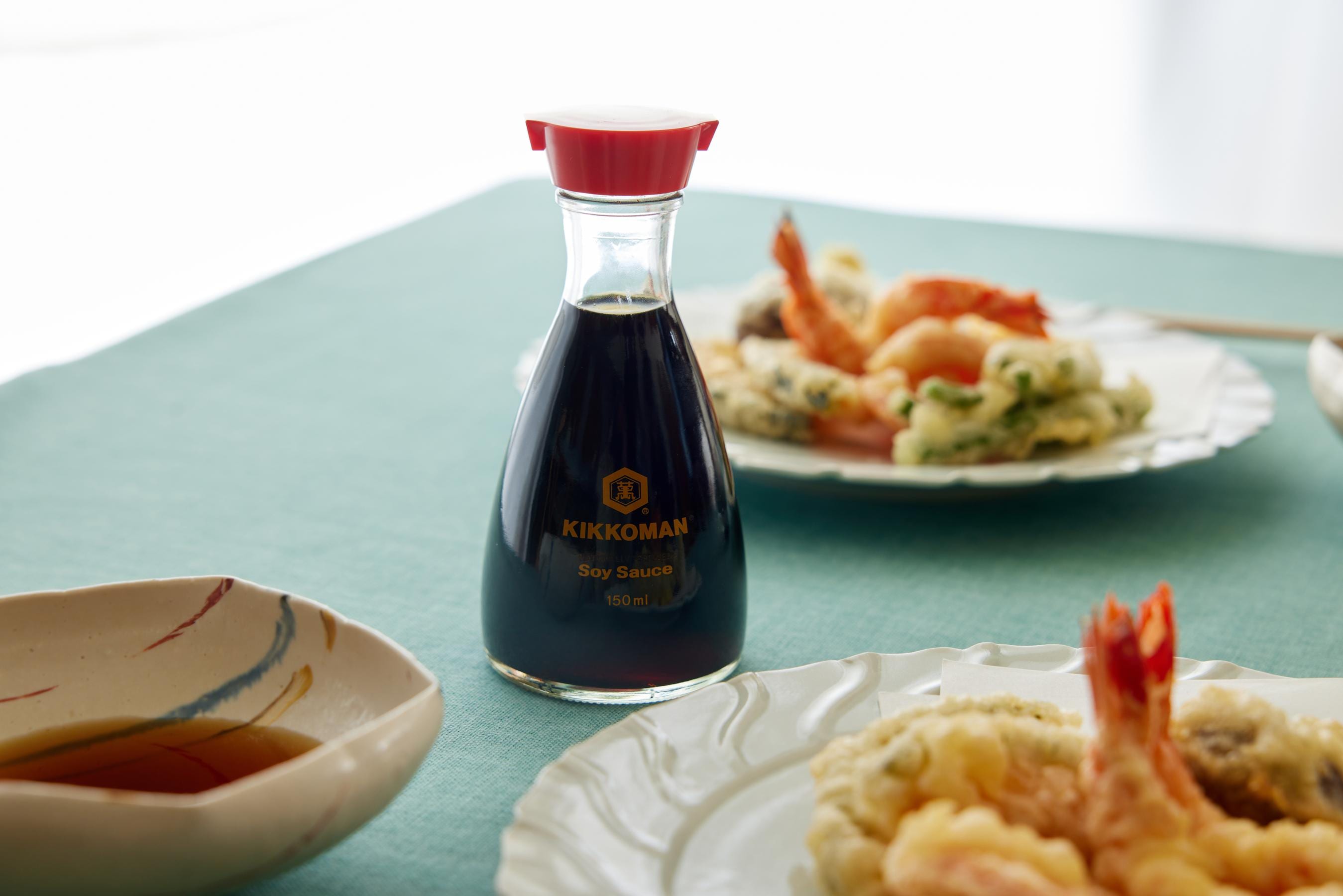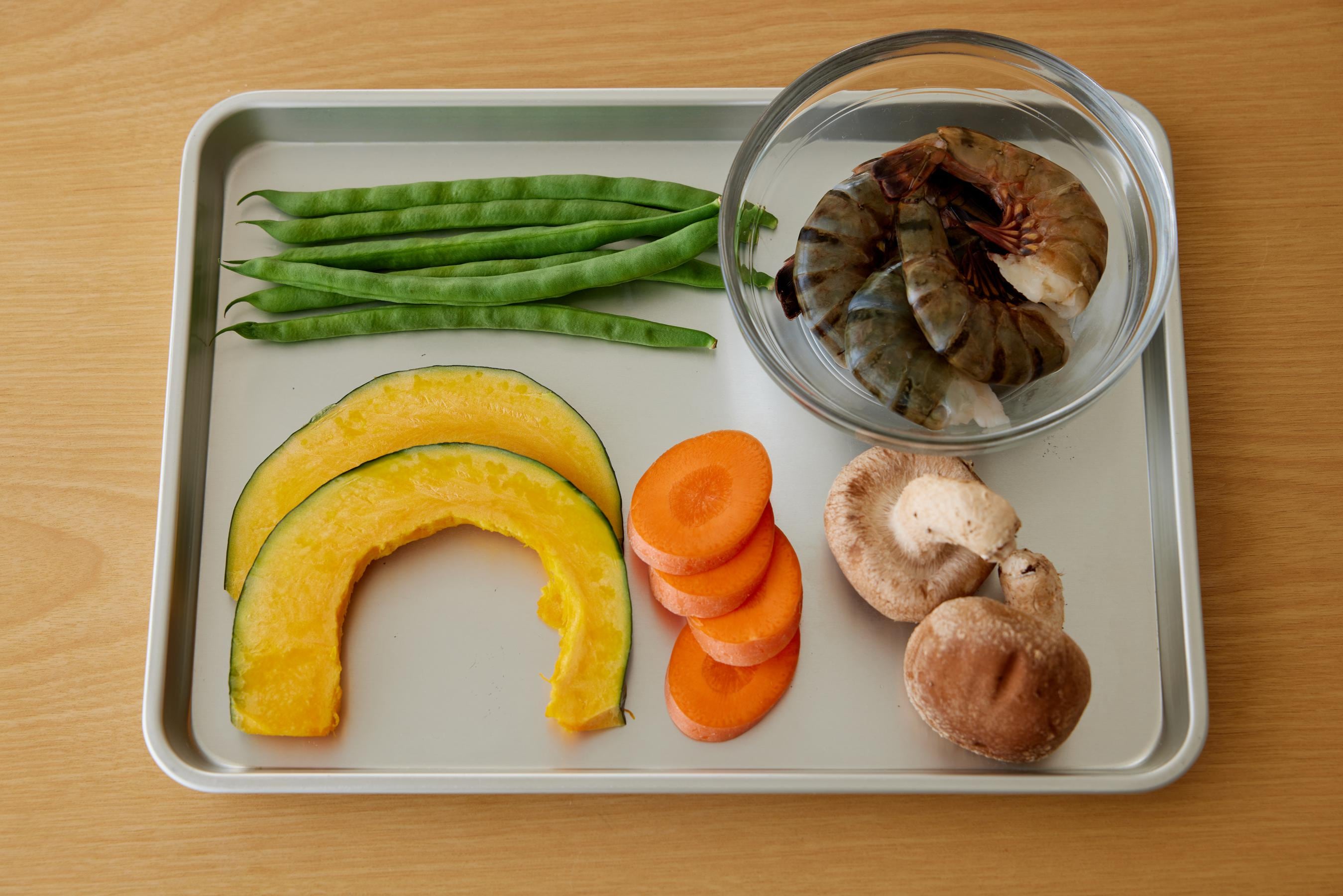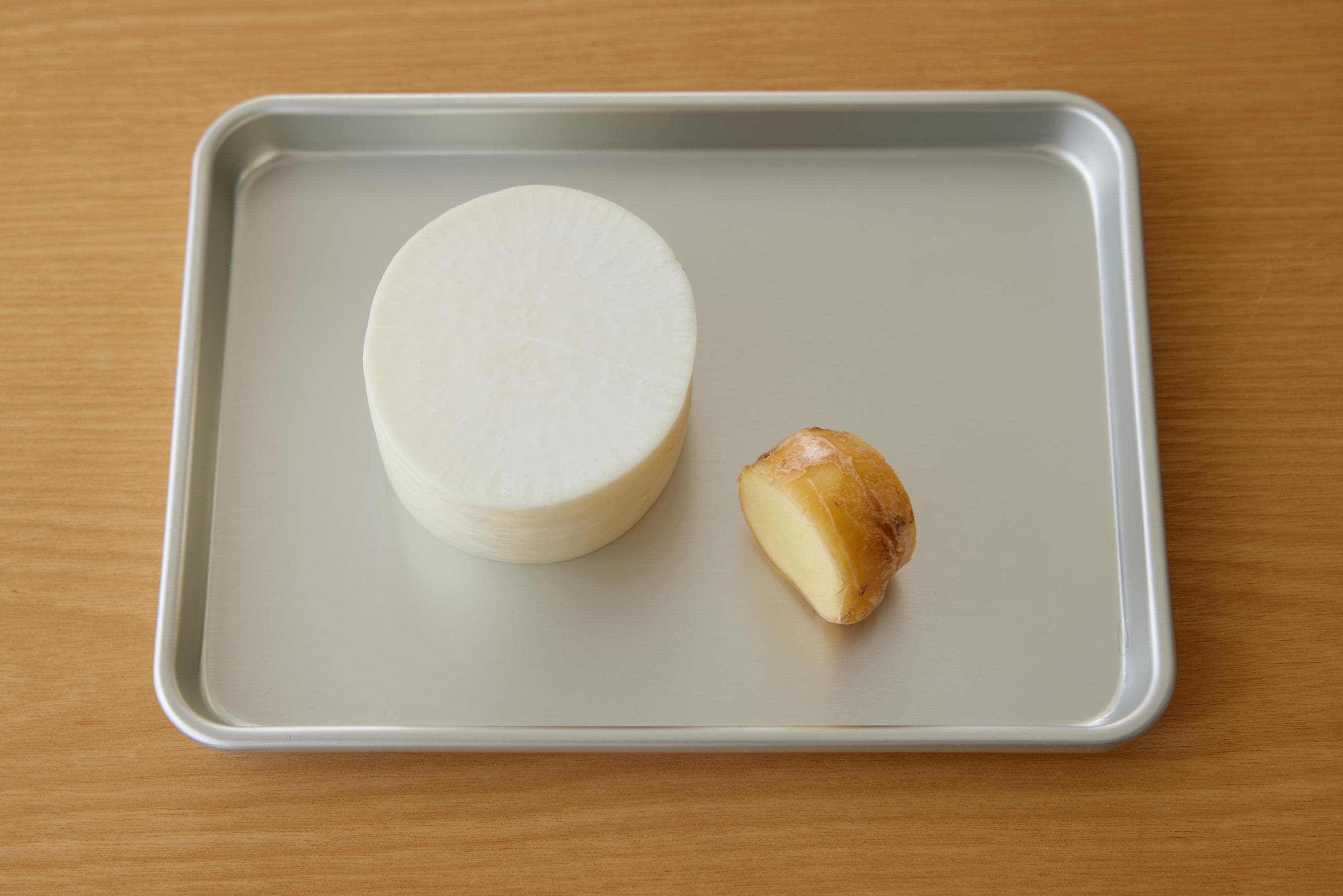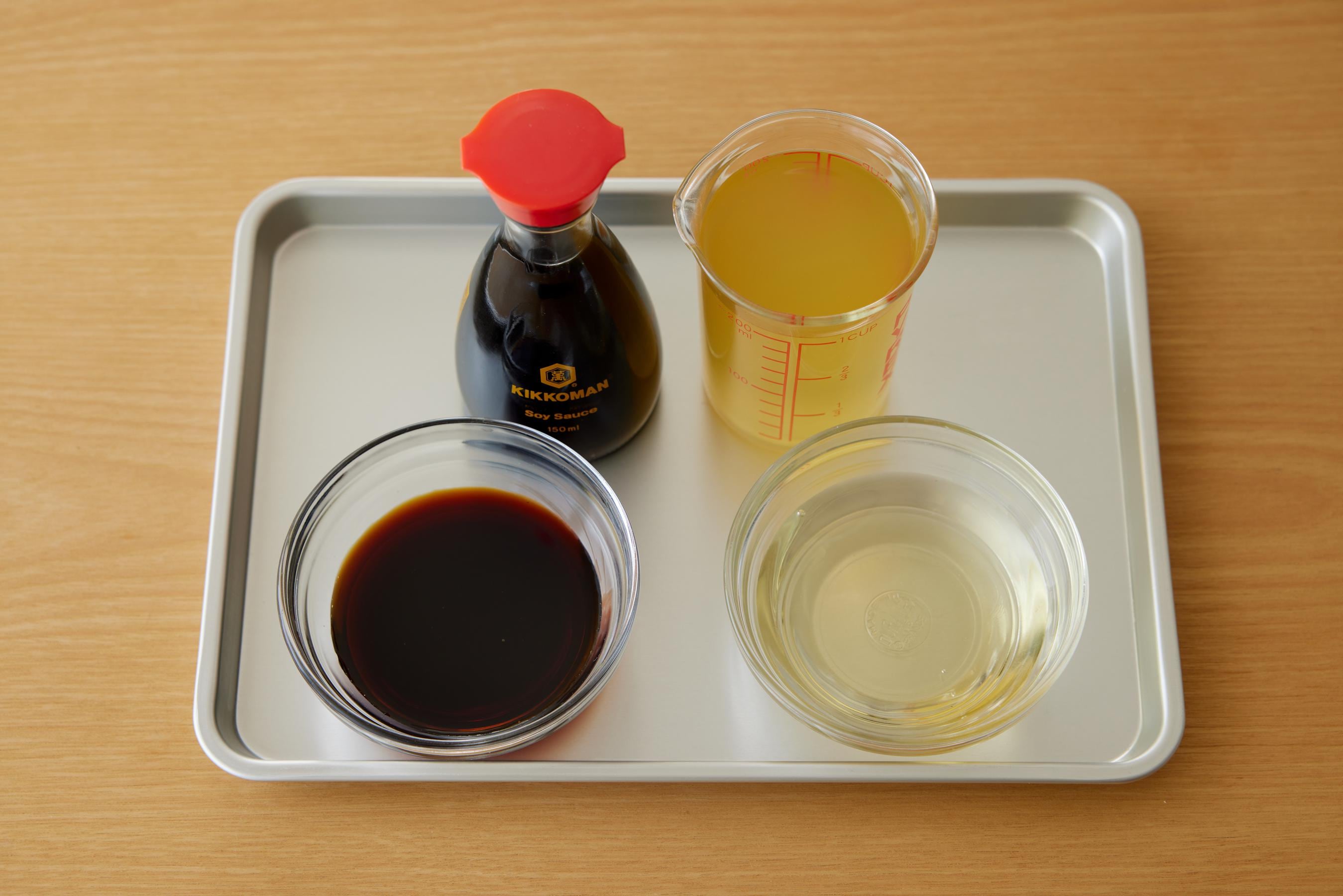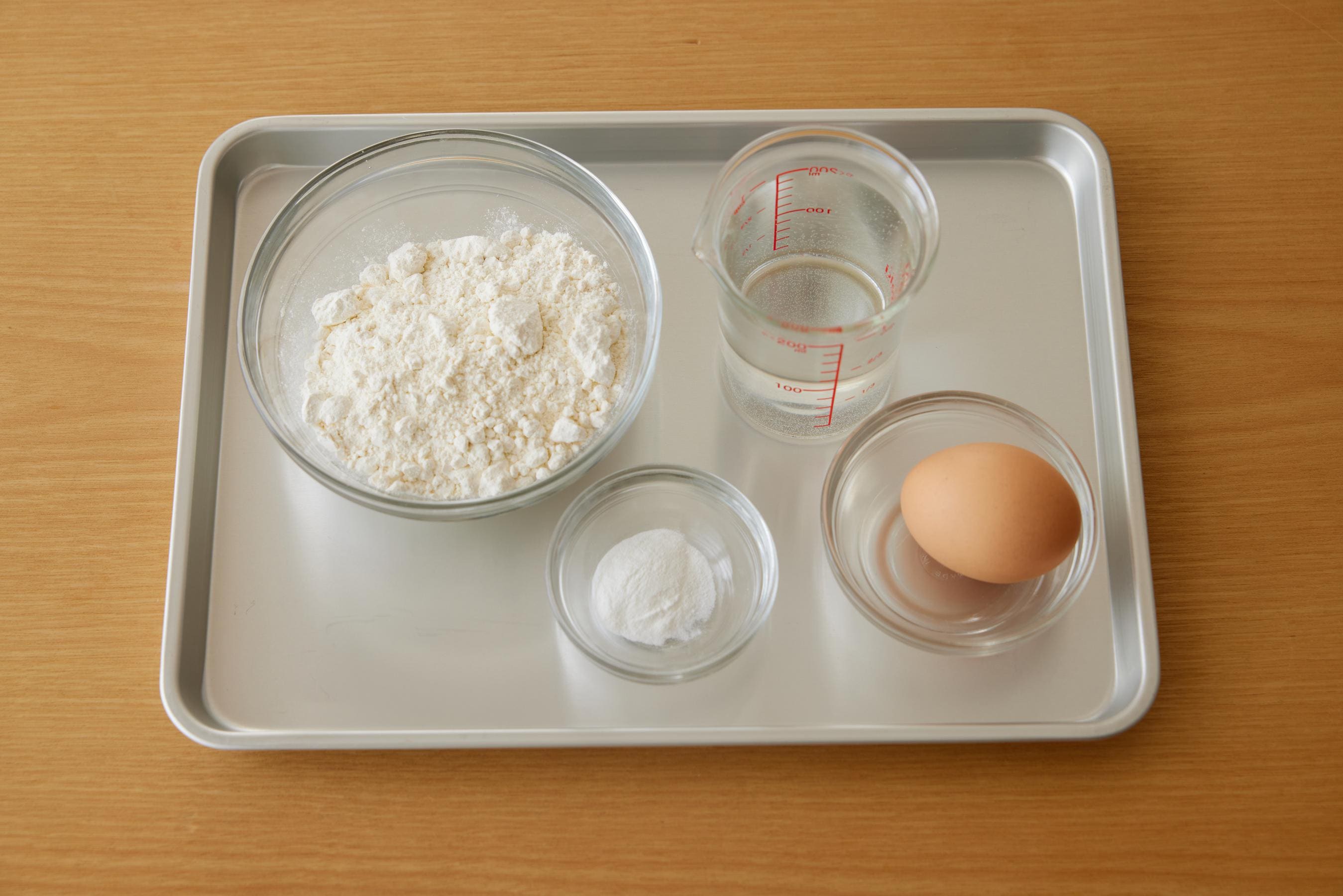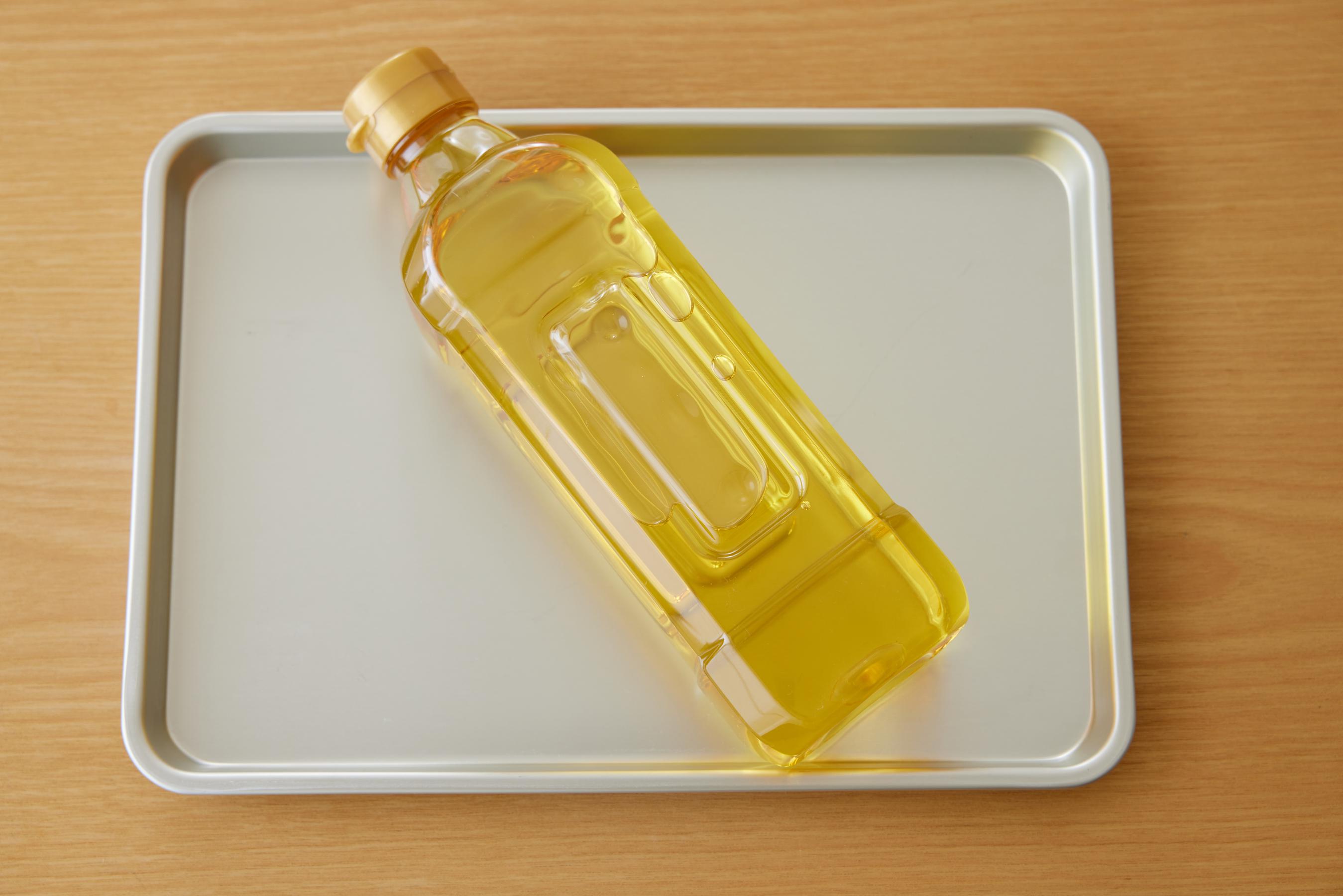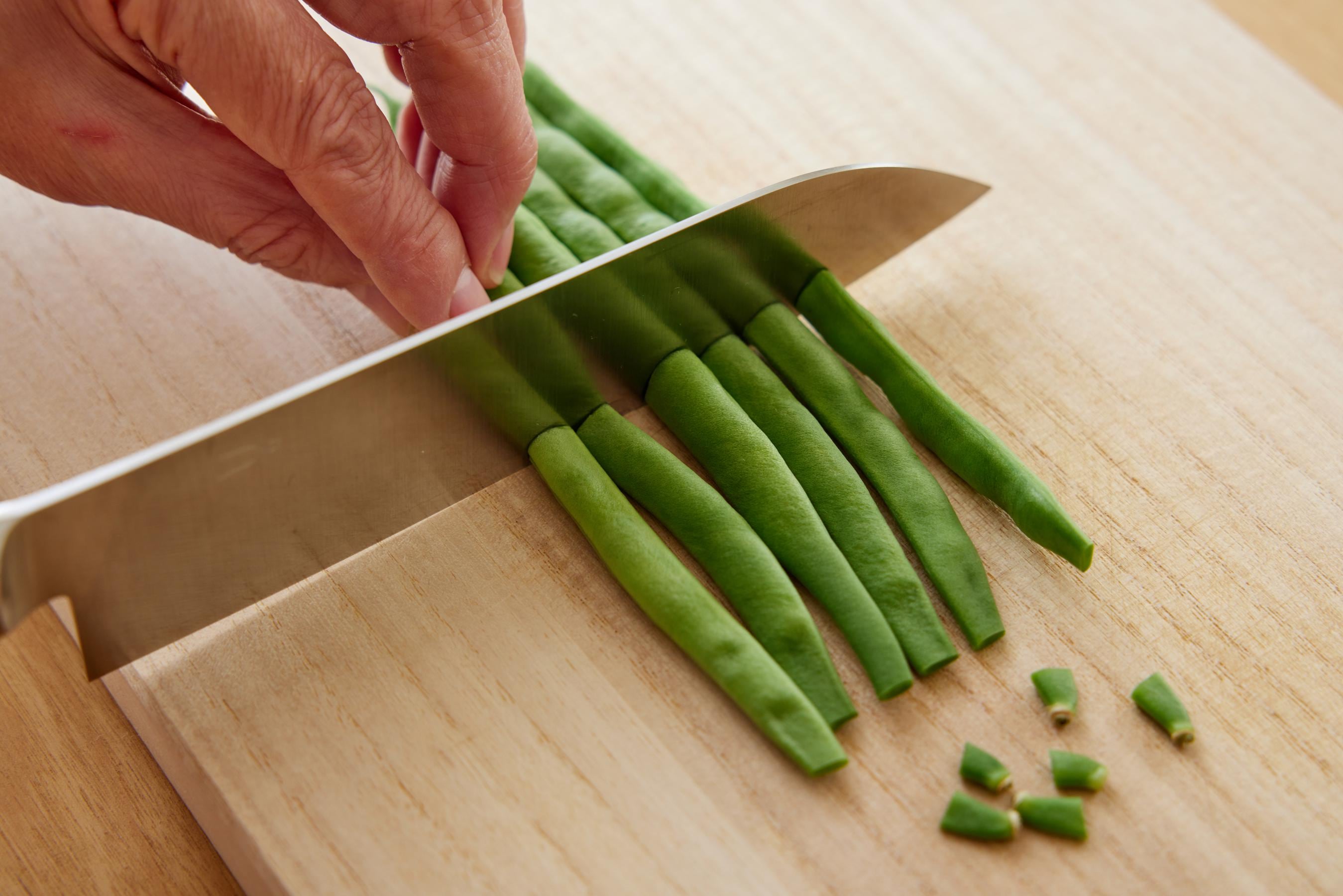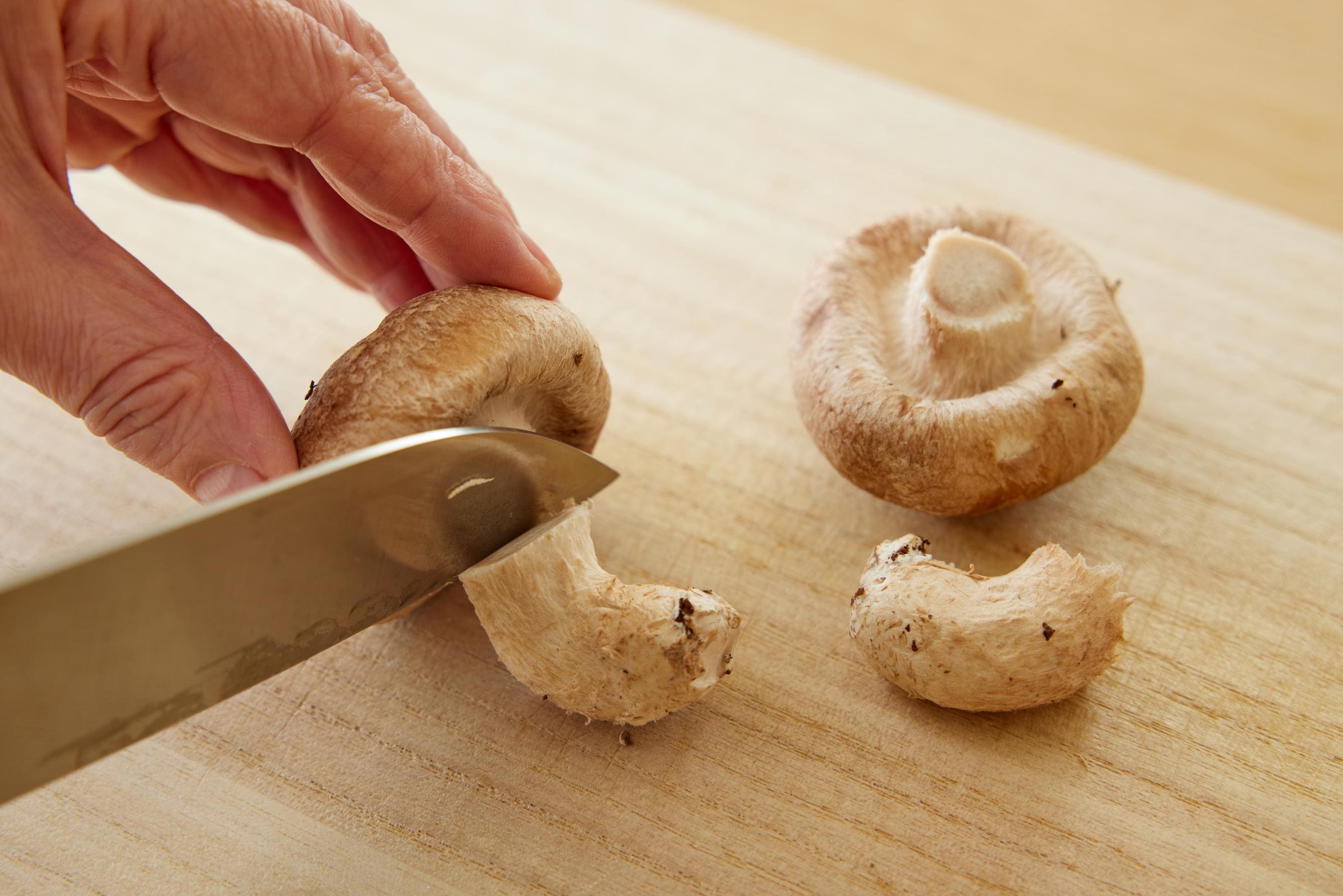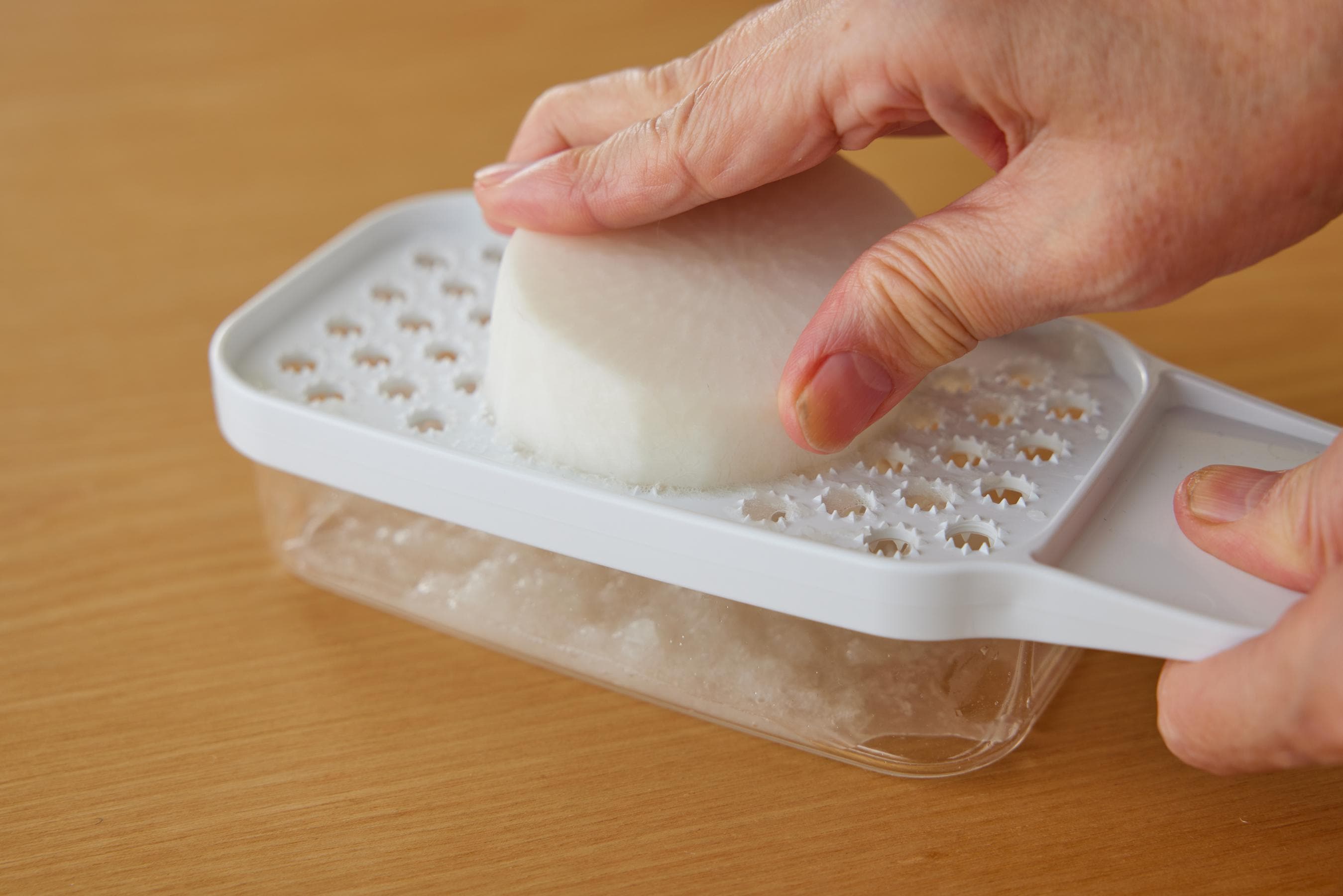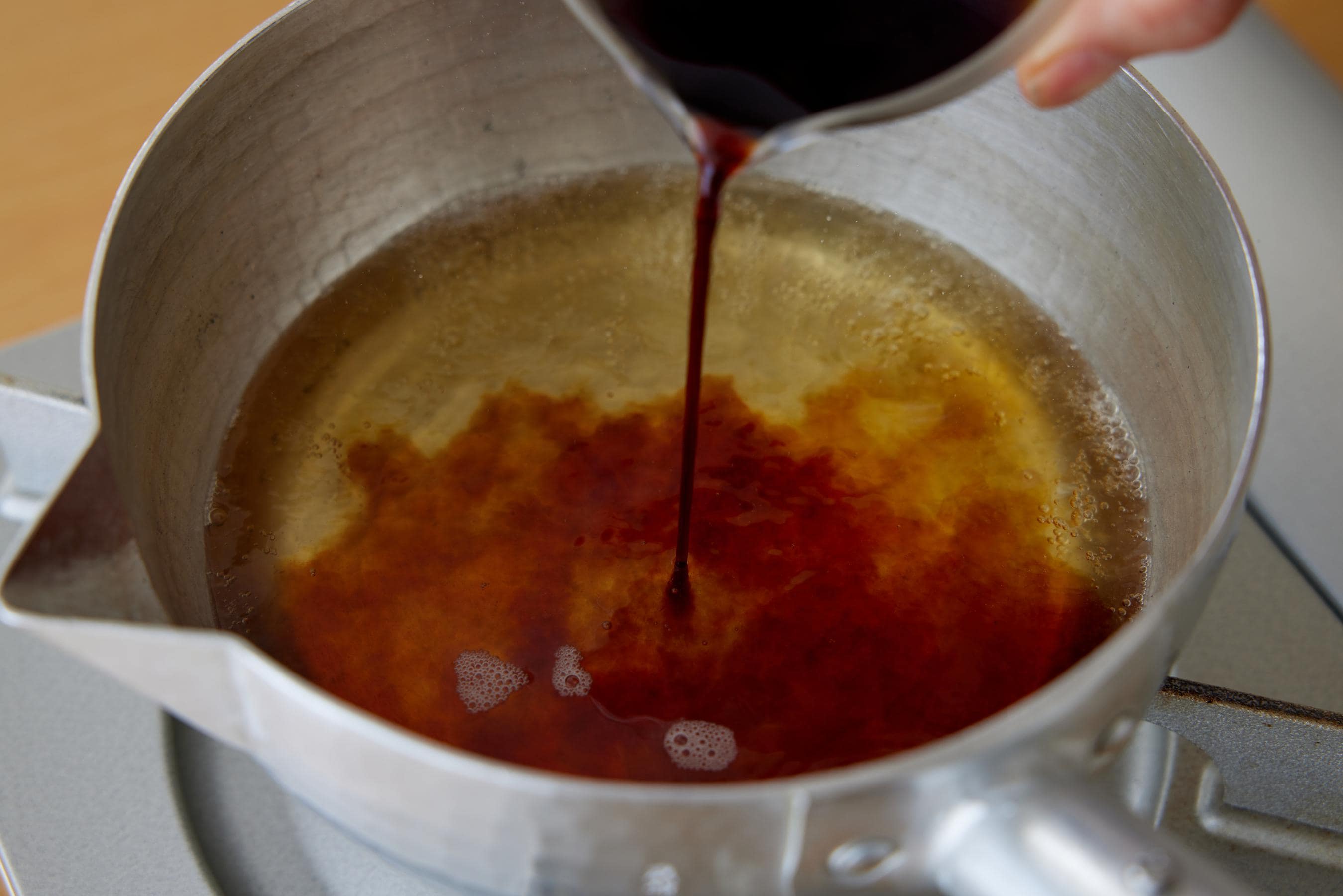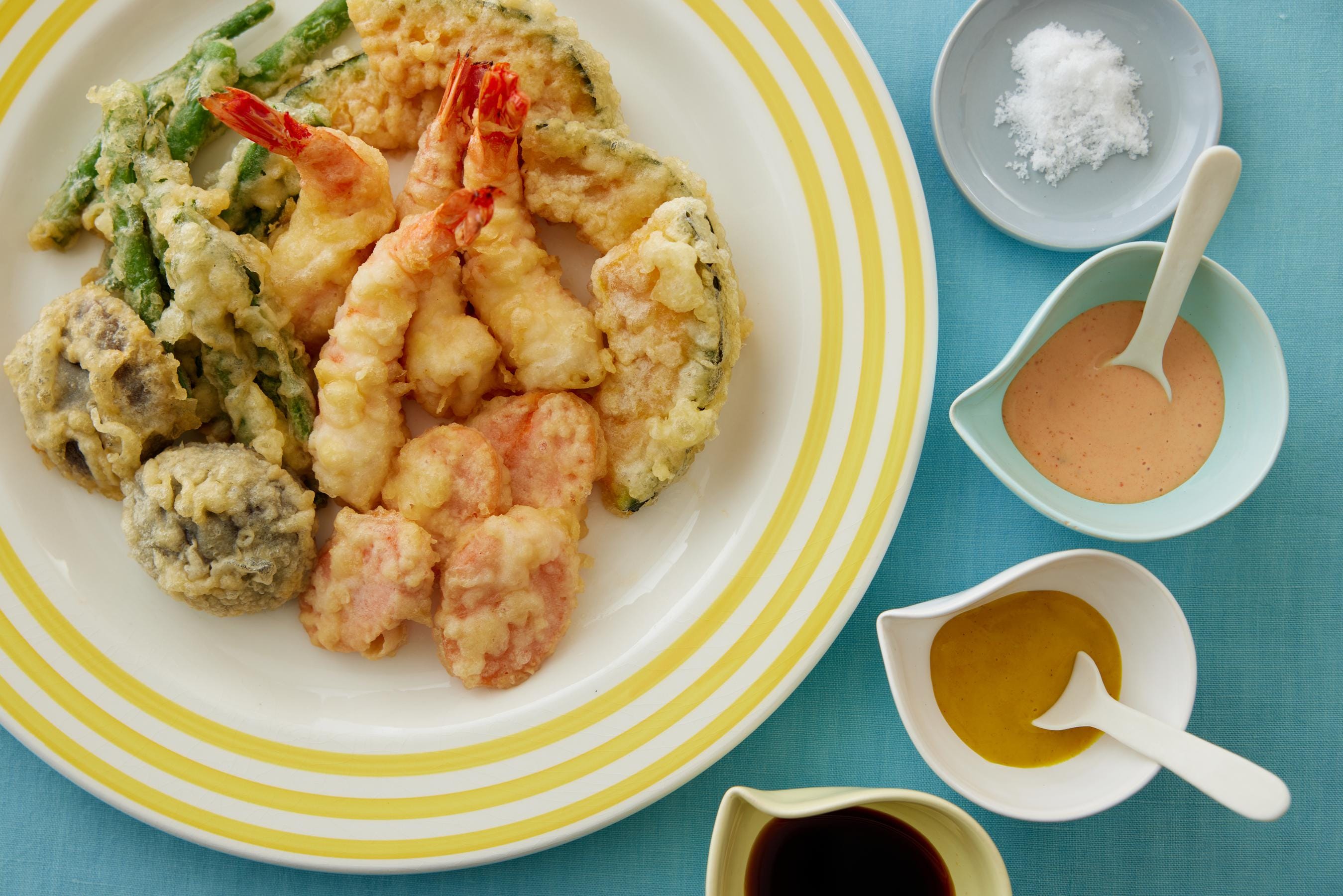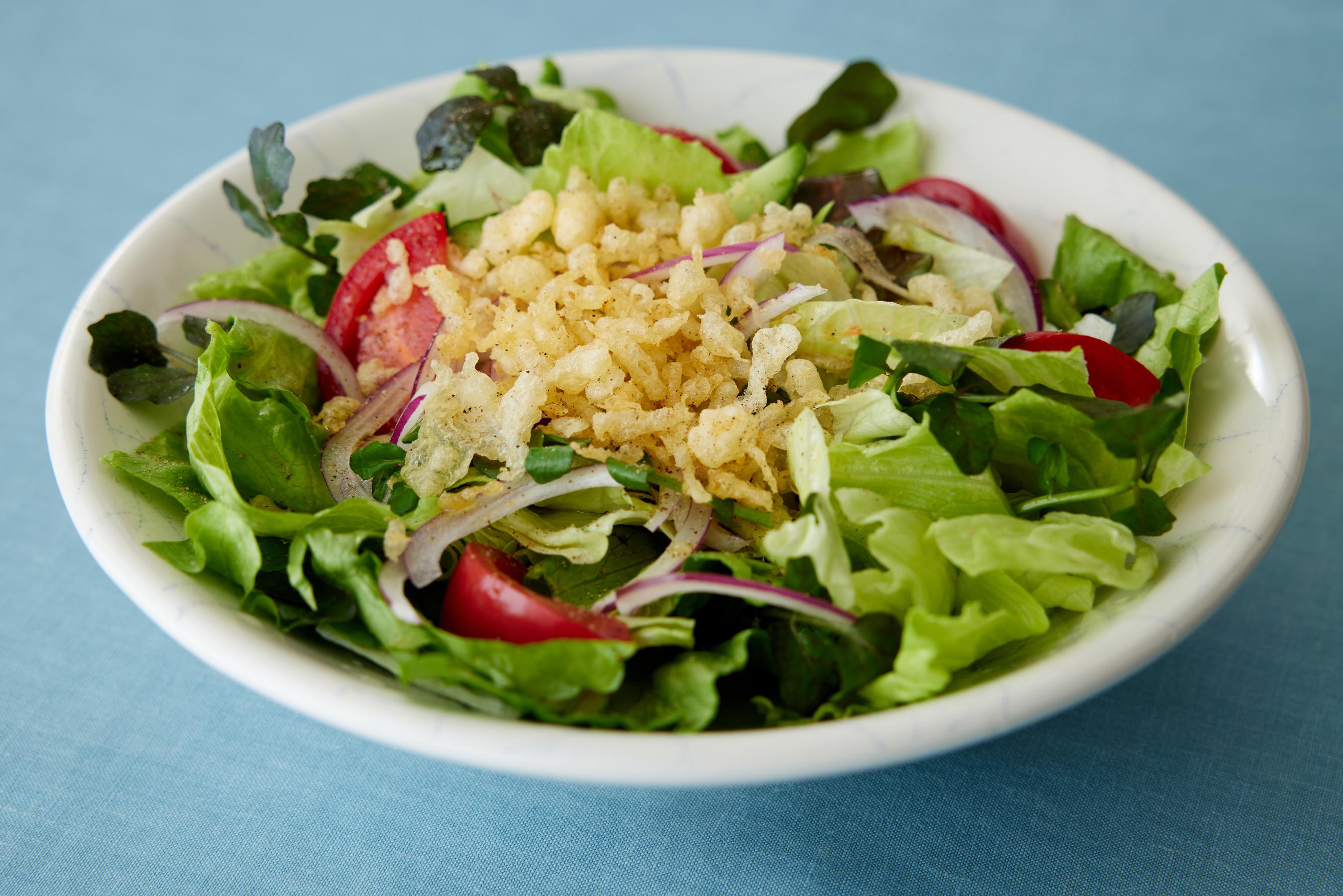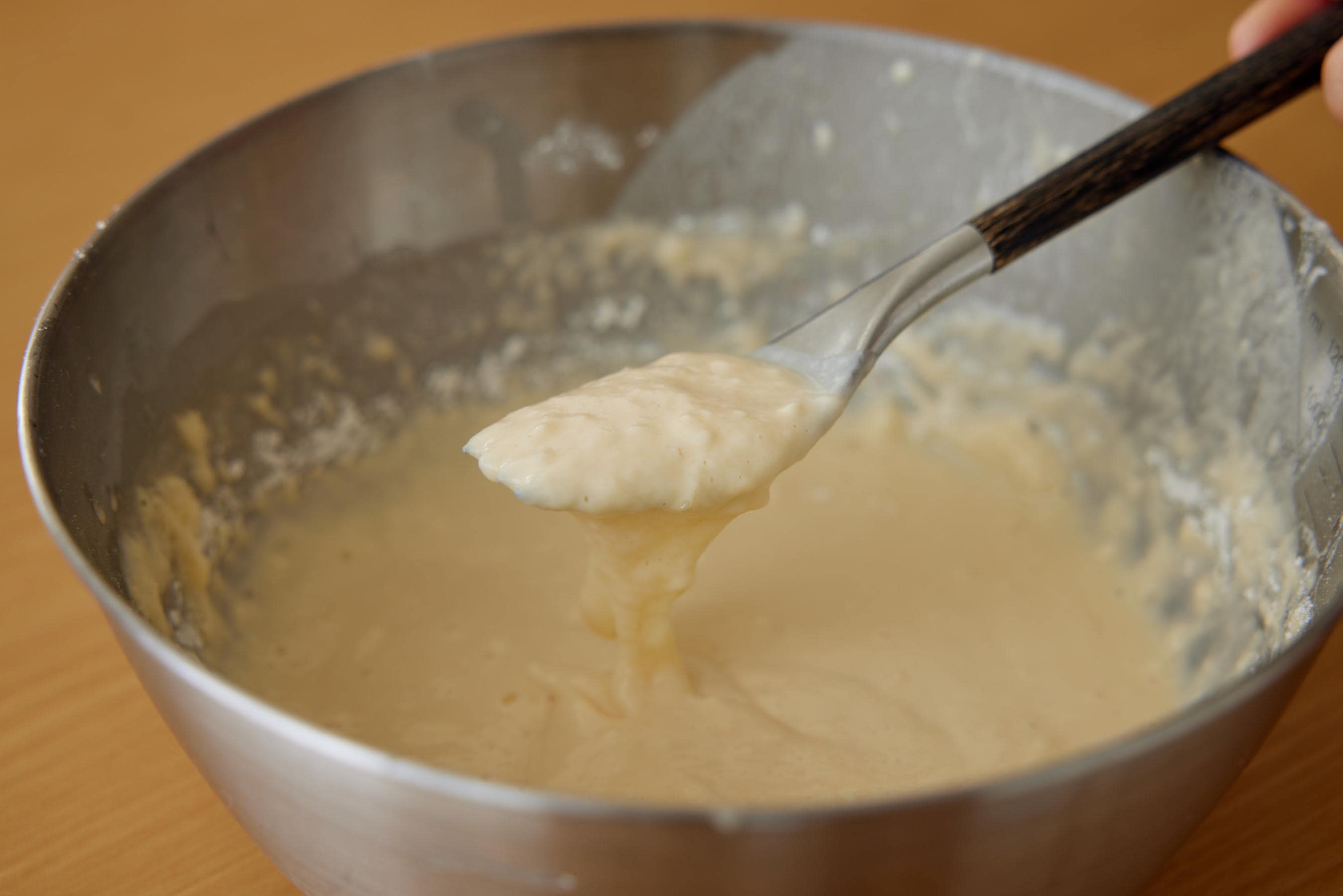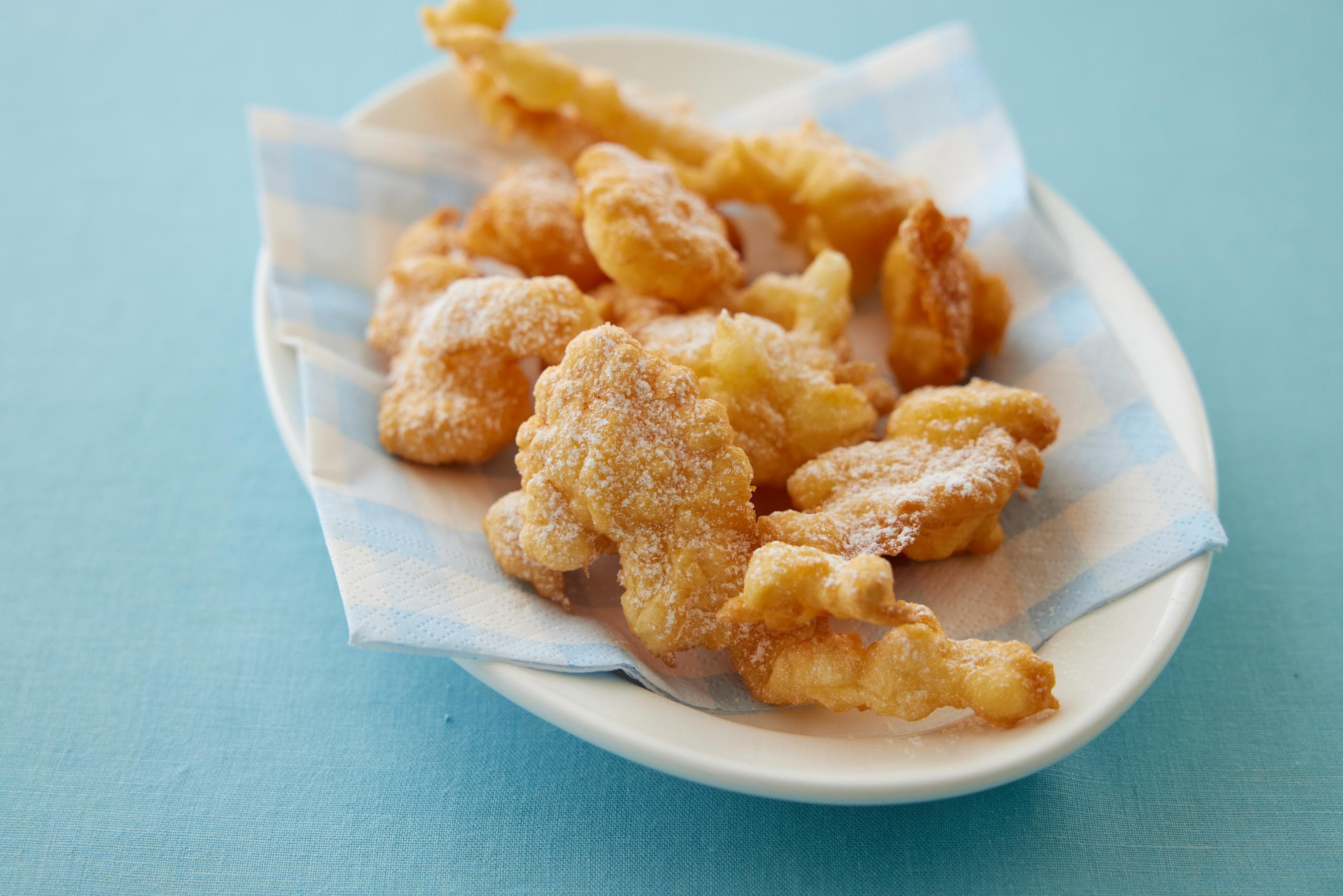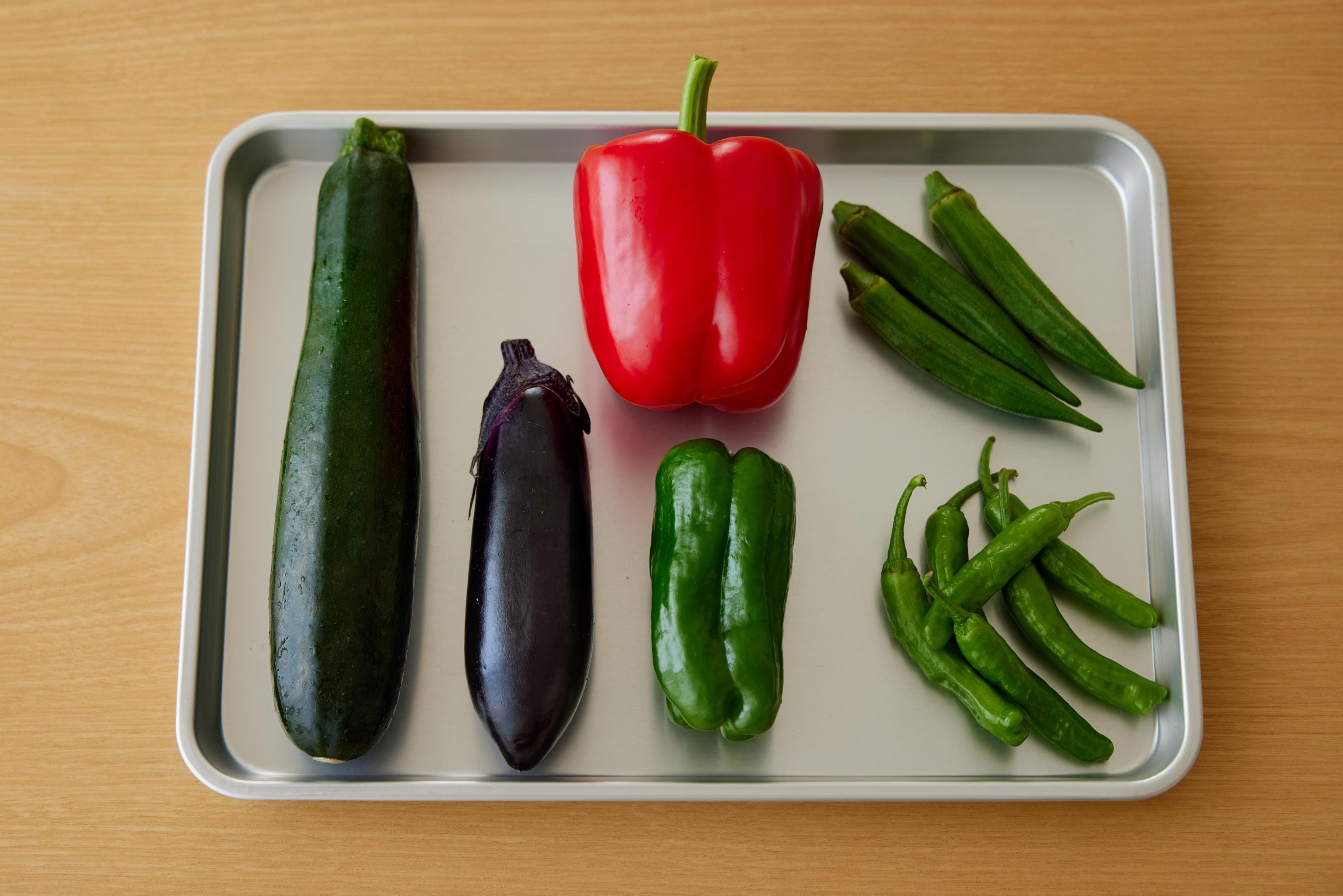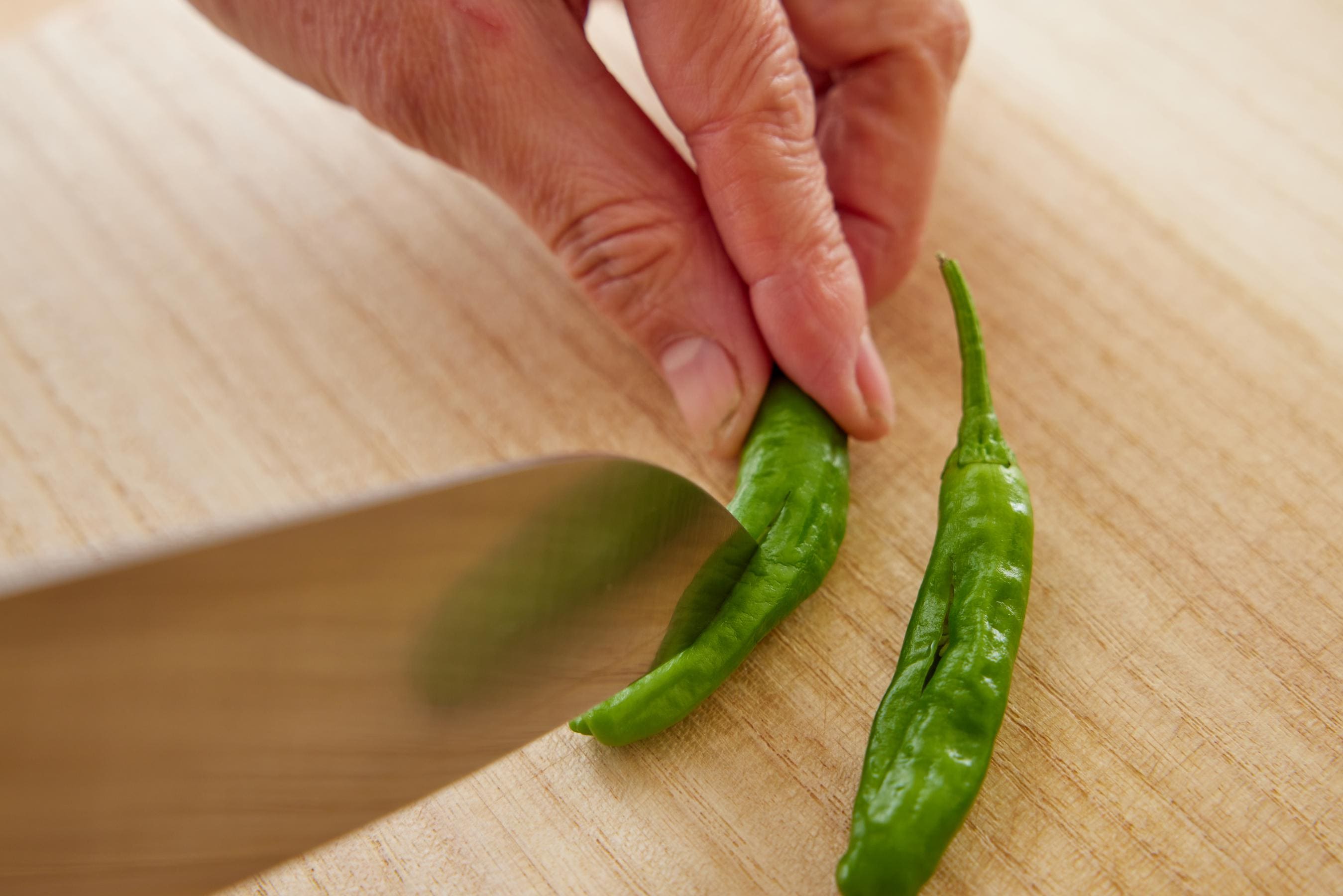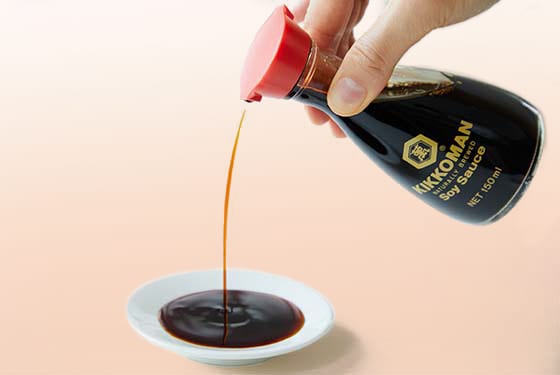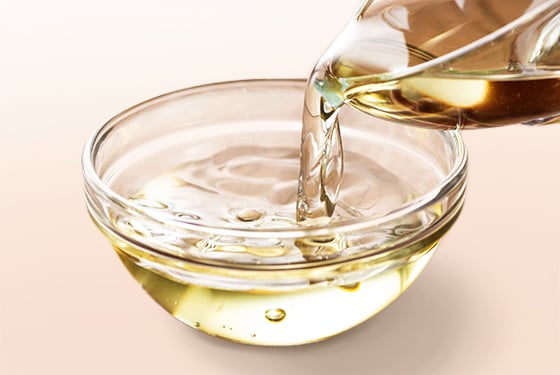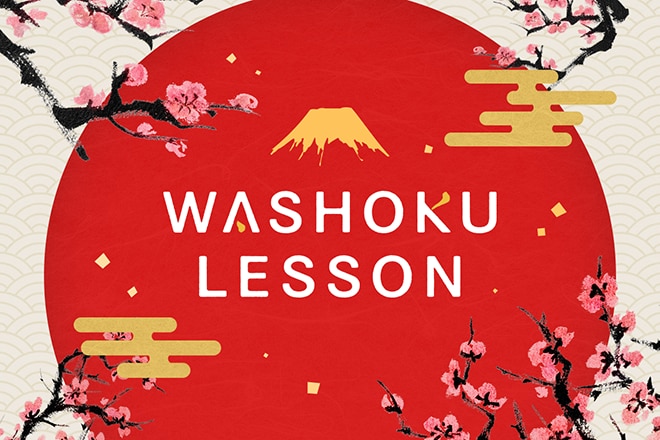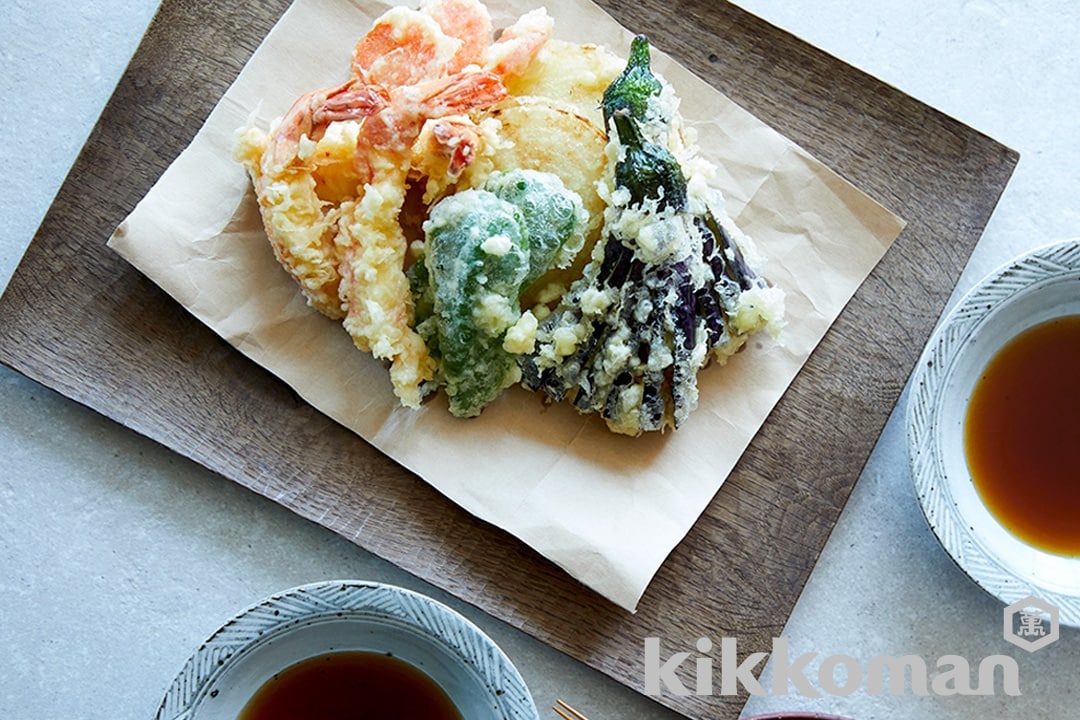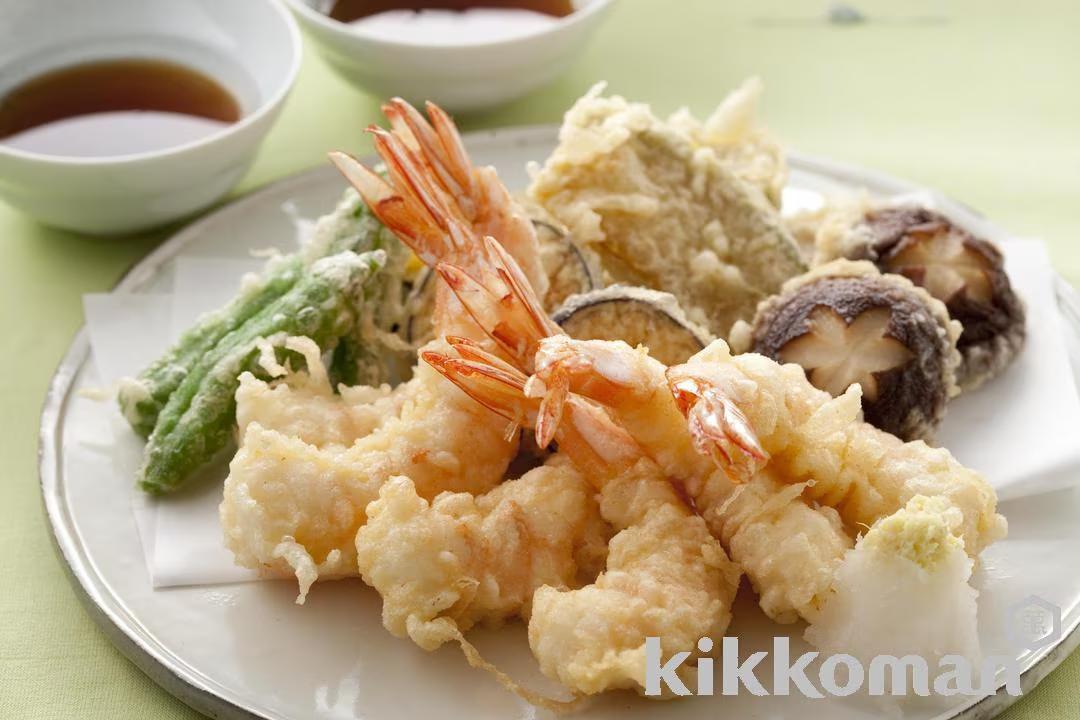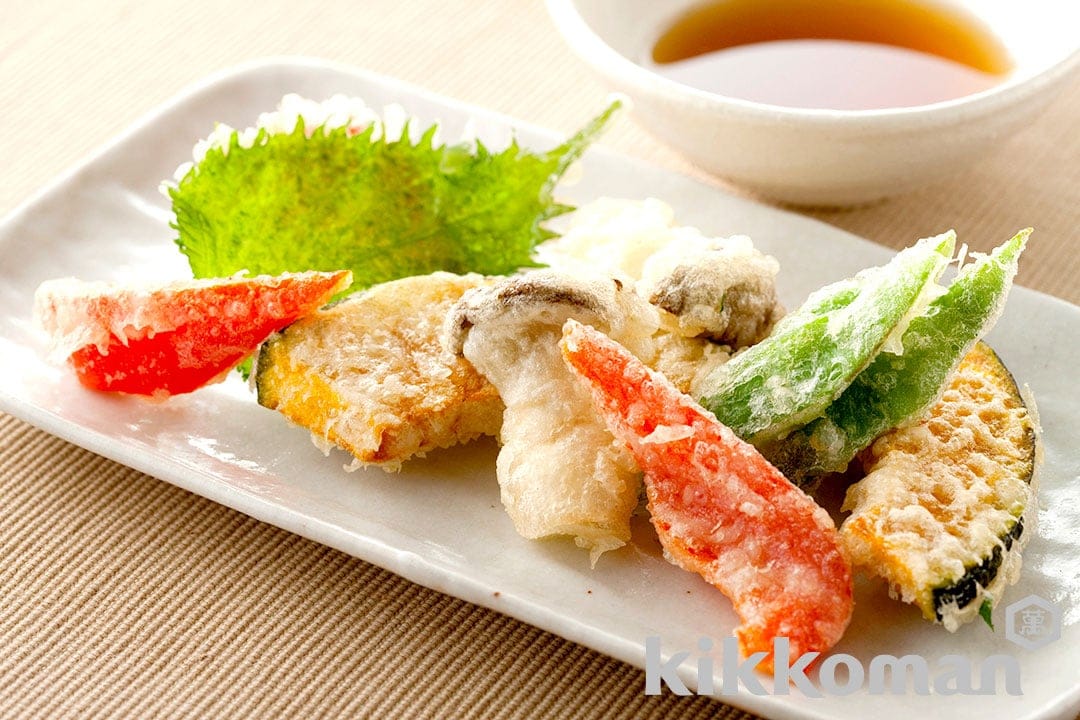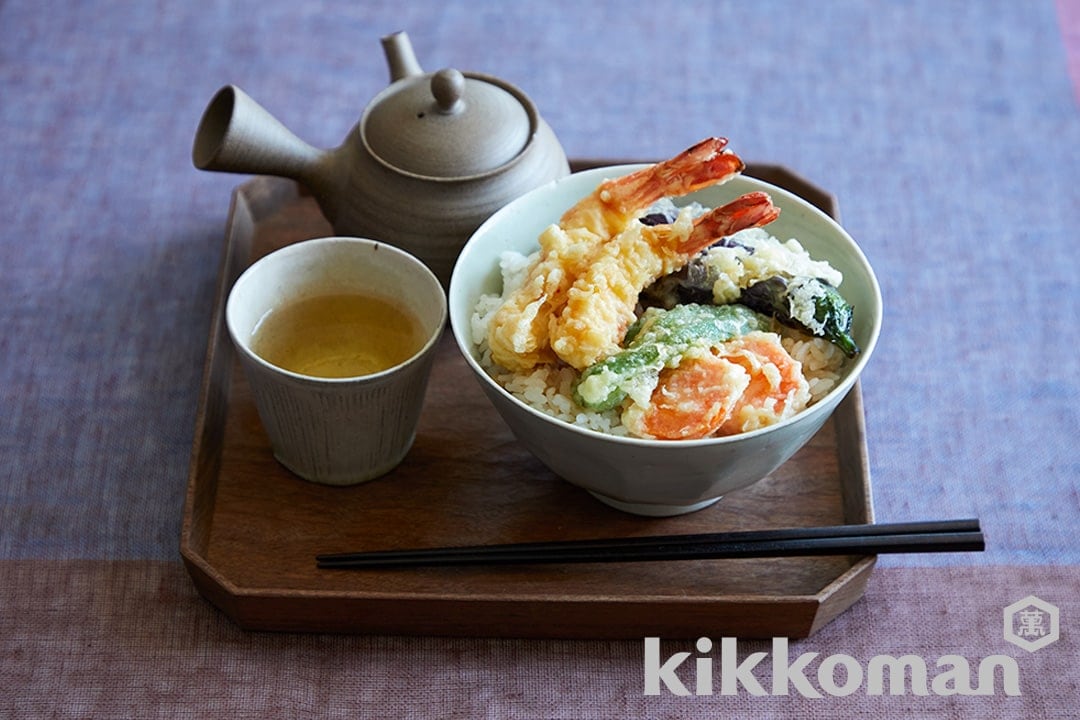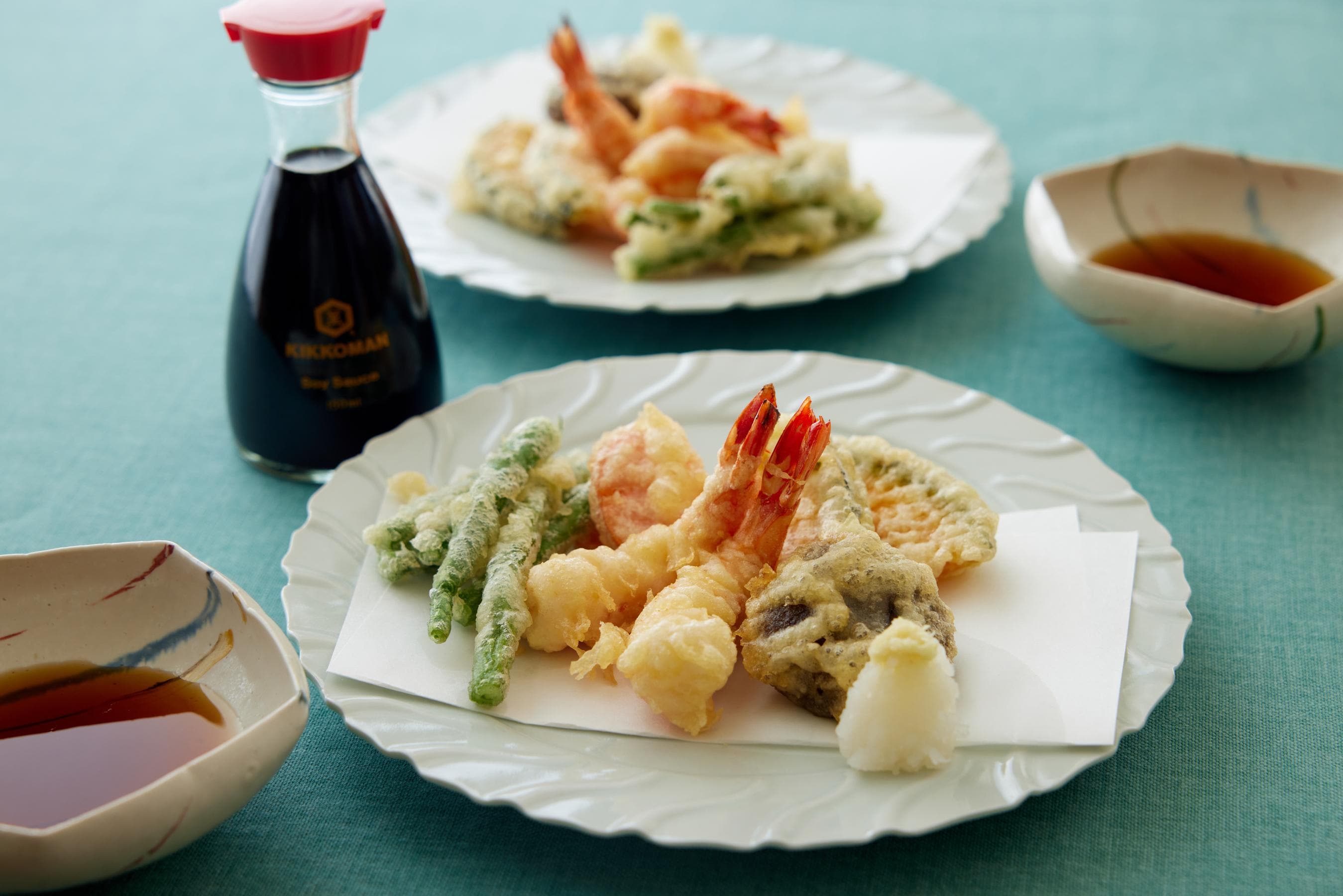
Deep frying brings out the best in vegetables and seafood. Serve with dashi broth-flavored “ten-tsuyu” (Tempura dipping sauce)!
- by Yuko Ihara
Table of Contents
- What is Tempura?
- The Secret to Delicious Flavor of Tempura
- Things to Remember When Cooking Tempura
- Ingredients for making Tempura
- Calories and Cooking Time
- How to Prepare Ingredients
- How to Prepare Garnish
- How to Make Tempura Dipping Sauce
- How to Make Tempura Batter
- How to Deep Fry the Tempura
- More Ways to Enjoy Tempura
- FAQ
- Kitchen Utensils Used in This Recipe
- Kikkoman Products Used in This Recipe
- About the Recipe Author
What is Tempura?
Tempura (天ぷら) is a traditional Japanese dish of vegetables and seafood covered in batter and fried in oil. Tempura first became popular during Japan’s Edo era (1603 - 1867). At the time, Tempura was a food to be eaten while standing at outdoor food stalls. But before long, Tempura restaurants mastered in frying techniques began to appear. From this, techniques distinct to Japanese “washoku” cuisine were developed, such as how to make batter, and how to draw out the ingredients’ inherent flavors.
The Secret to Delicious Flavor of Tempura
Things to Remember When Cooking Tempura
The delicious flavor of Tempura lies in how its vegetables and seafood ingredients are coated in a thin layer of batter and heated as if steaming, which preserves the flavors and umami of the ingredients. Therefore, how the batter is prepared, and the amount and temperature of oil used during frying are decisive factors for flavor.
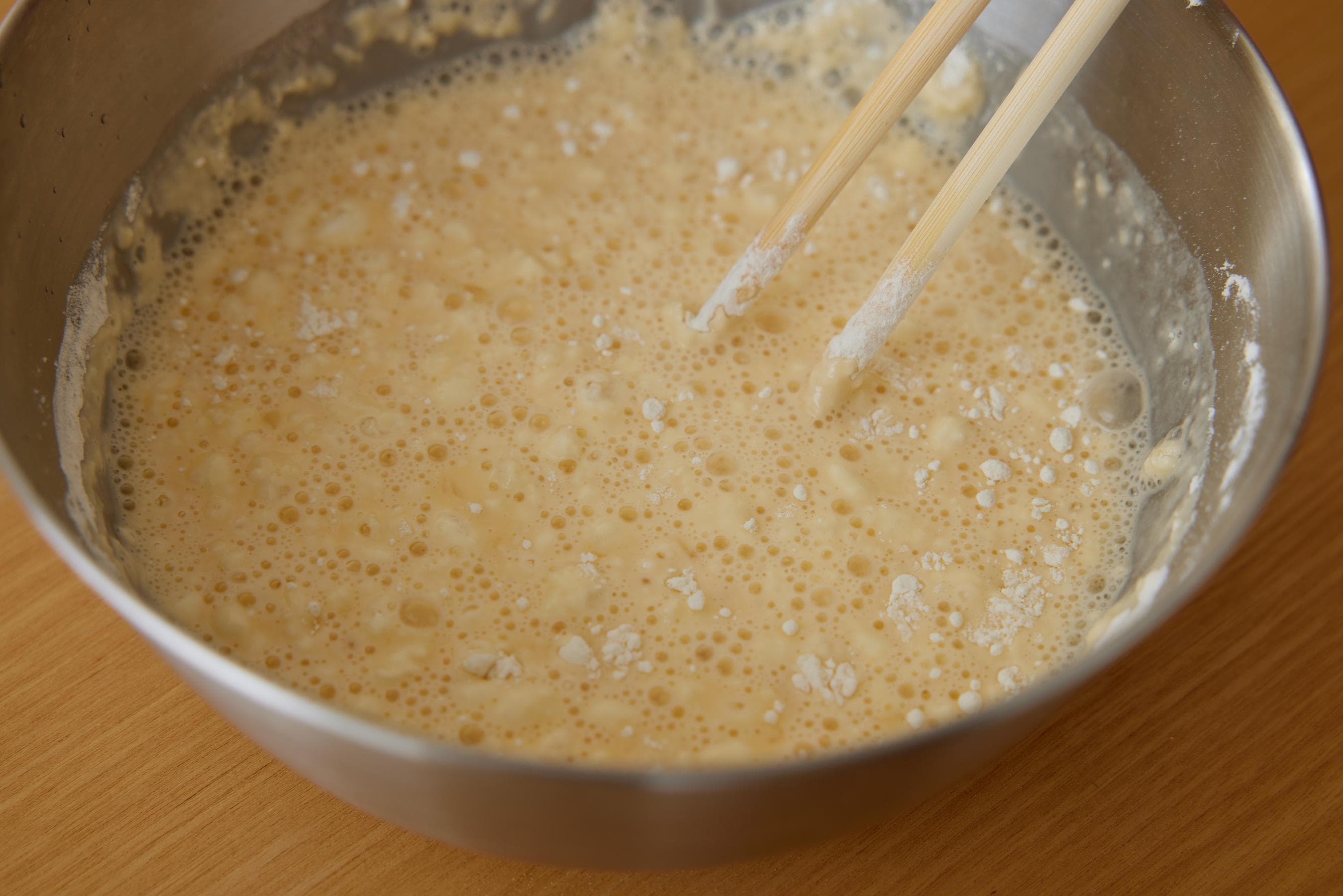
Preventing Gluten from Forming in the Batter
Tempura is made using cake flour. The reason for this is to avoid the formation of gluten as much as possible. If there is too much gluten, the batter will be sticky and moisture will not drain out properly, making it harder to achieve a crispy texture when frying the Tempura. To prevent gluten from forming, use cold water and avoid over-stirring. When combining the flour and water, mix only slightly in order to create a lighter batter.
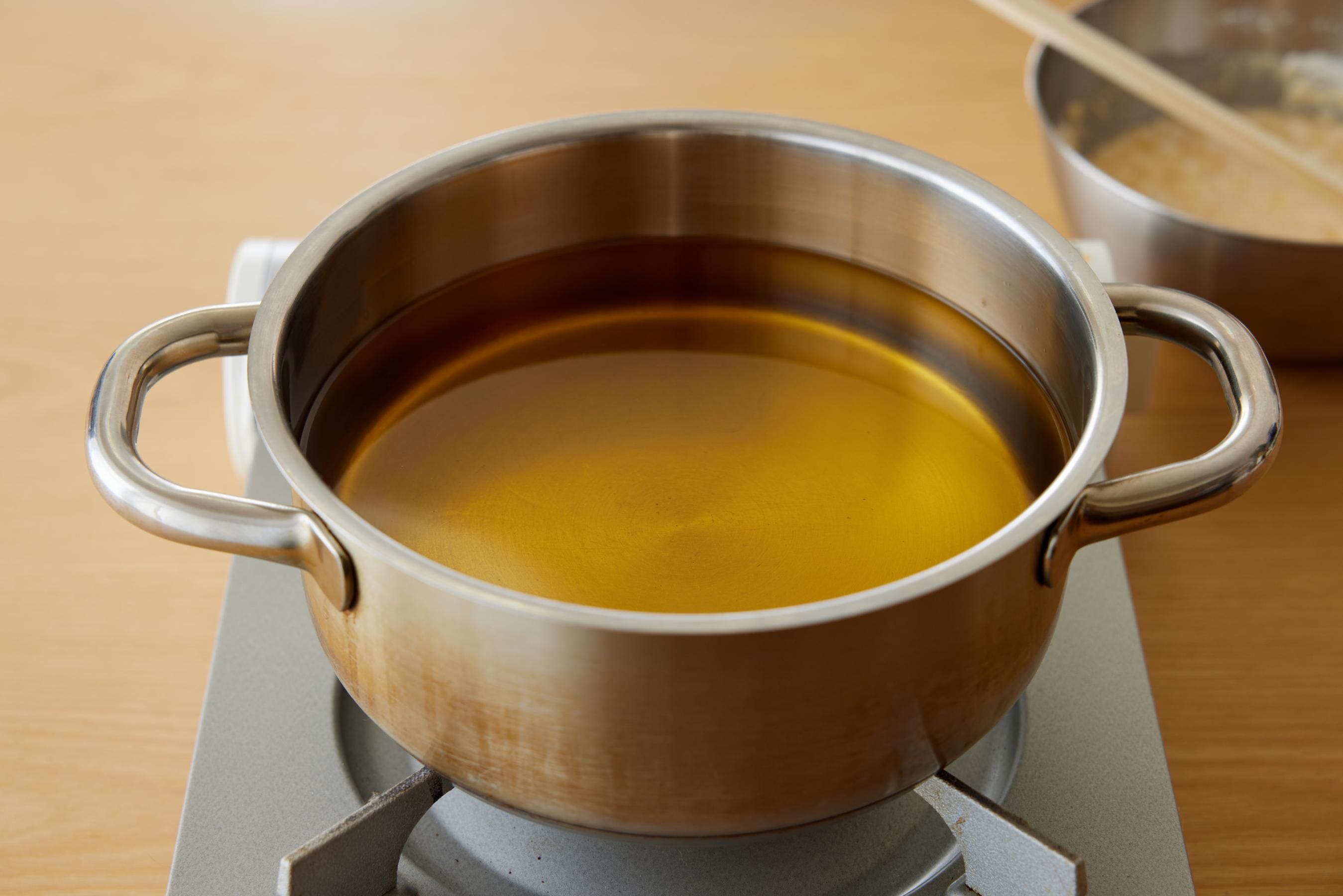
Using a Large Ratio of Cooking Oil
When frying Tempura, it is best to have the ingredients almost “swimming” in the hot oil. This is because if too many ingredients are added at once, the oil temperature will drop rapidly. By maintaining the temperature of the oil, the ingredients will be evenly cooked and the batter will fry more thoroughly. Also, to bring out the flavor of the vegetable and seafood ingredients, use vegetable oil with as little flavor and aroma as possible.
Ingredients for Making Tempura (Servings: 2)
Main Ingredients
black tiger shrimp (headless, with shells) - 4
green beans - 4
carrots (thinly sliced) - 4 slices
shiitake mushrooms (fresh) - 2
kabocha squash (thinly sliced) - 2 slices
Garnish
daikon radish - 5 cm (2 in.)
ginger - 1 knob
Tempura Dipping Sauce
Kikkoman Soy Sauce - 3 Tbsp
Mirin - 4 Tbsp
Dashi/Japanese broth - 200 ml (6.8 fl.oz.)
Tempura Batter
Frying Oil
Calories and Time

* Nutrition facts are for one serving
How to Prepare Ingredients
Preparing the Vegetables
Remove the stems from the green beans, then slice each green bean into 2 pieces. Cut the stems off of the shiitake mushrooms. Cut the slices of kabocha squash in half.
Preparing the Shrimp
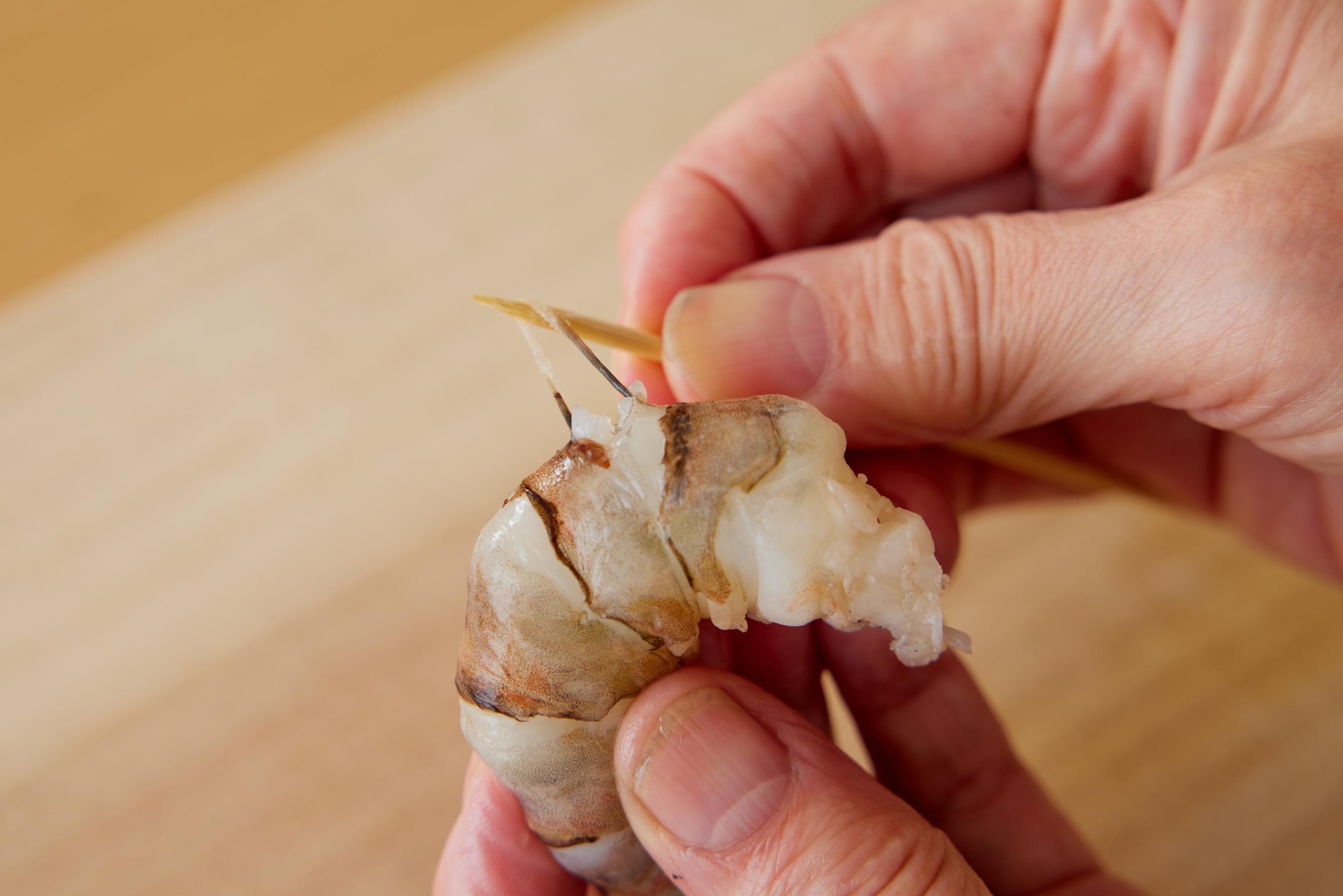
- 1Shell the shrimp, leaving the section leading to the tail, and use a bamboo skewer to remove the vein.
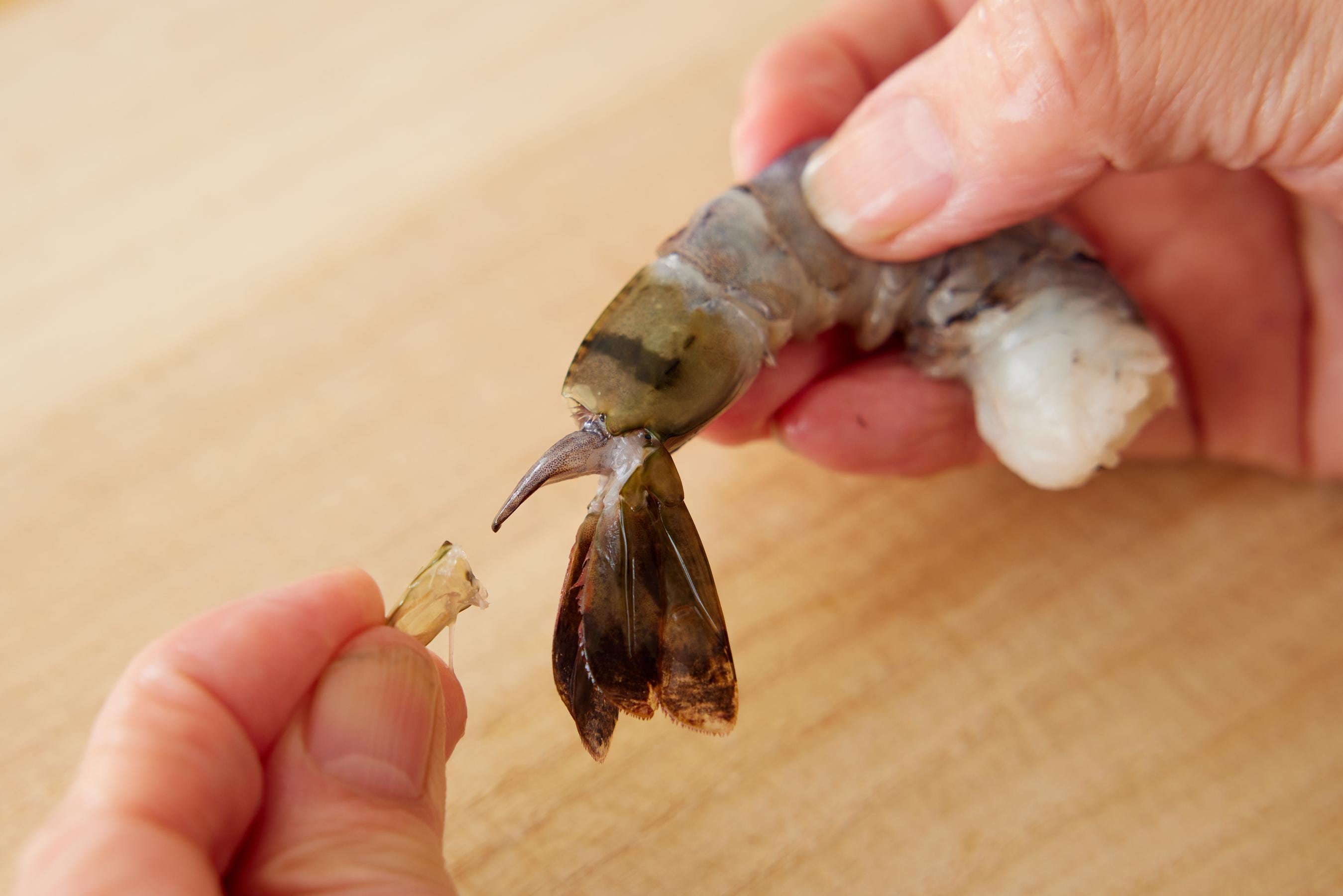
- 2Remove the sharp part of the shell at the base of the tail by pushing the shell upward and pulling.
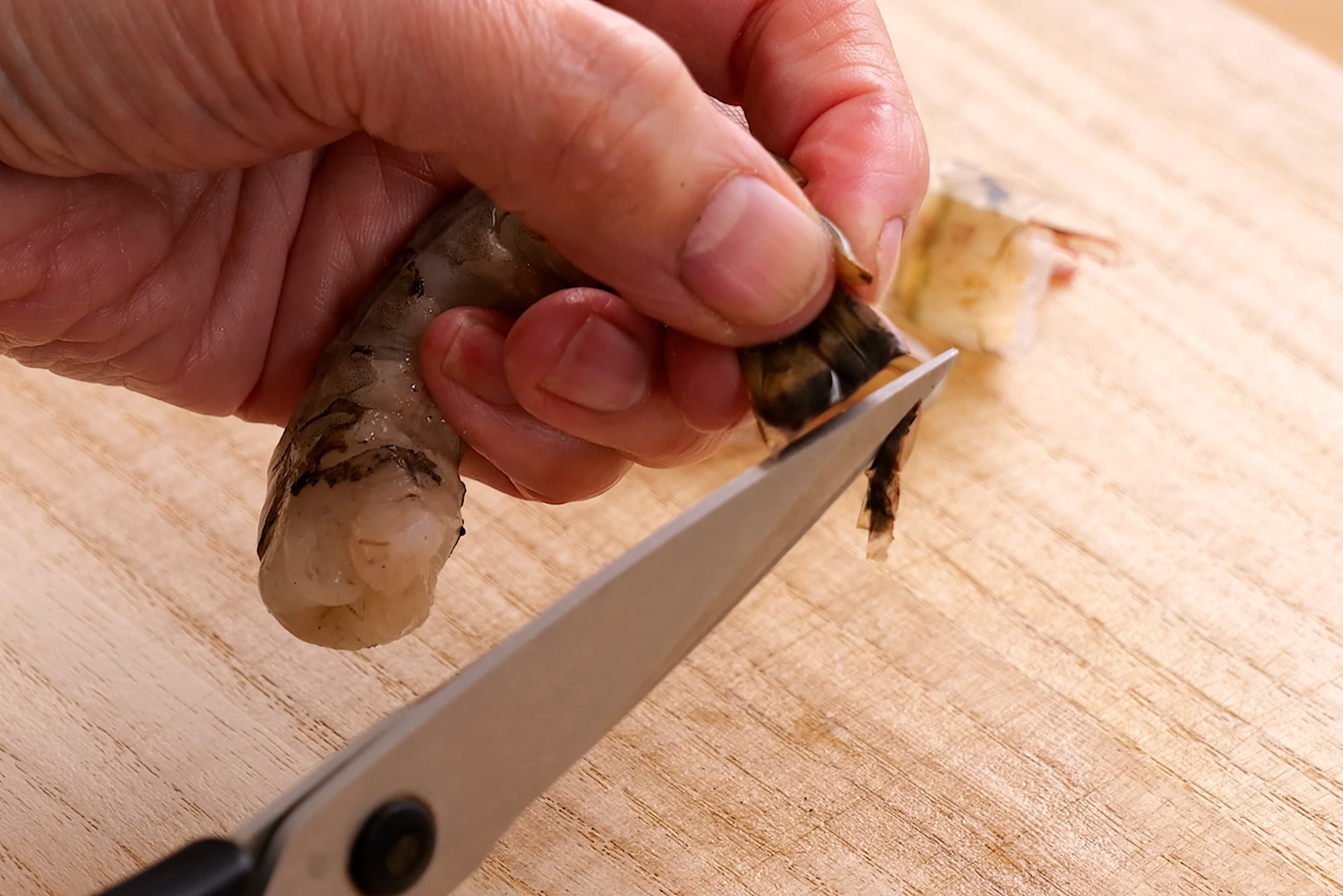
- 3Cut off the tip of the tail with kitchen scissors, then rinse well with water and wipe dry thoroughly.
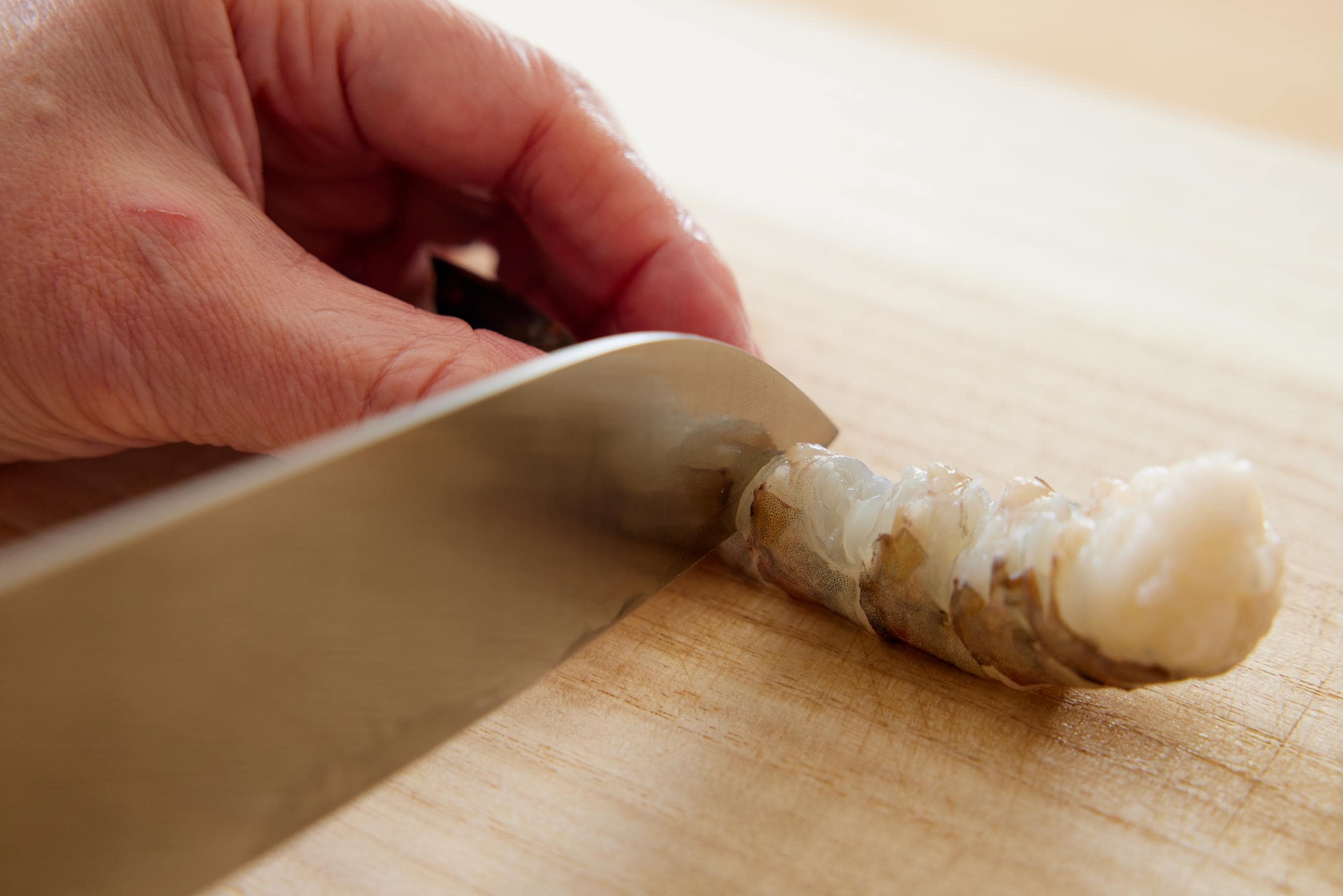
- 4Make 3 or 4 shallow incisions along the underside of the shrimp.
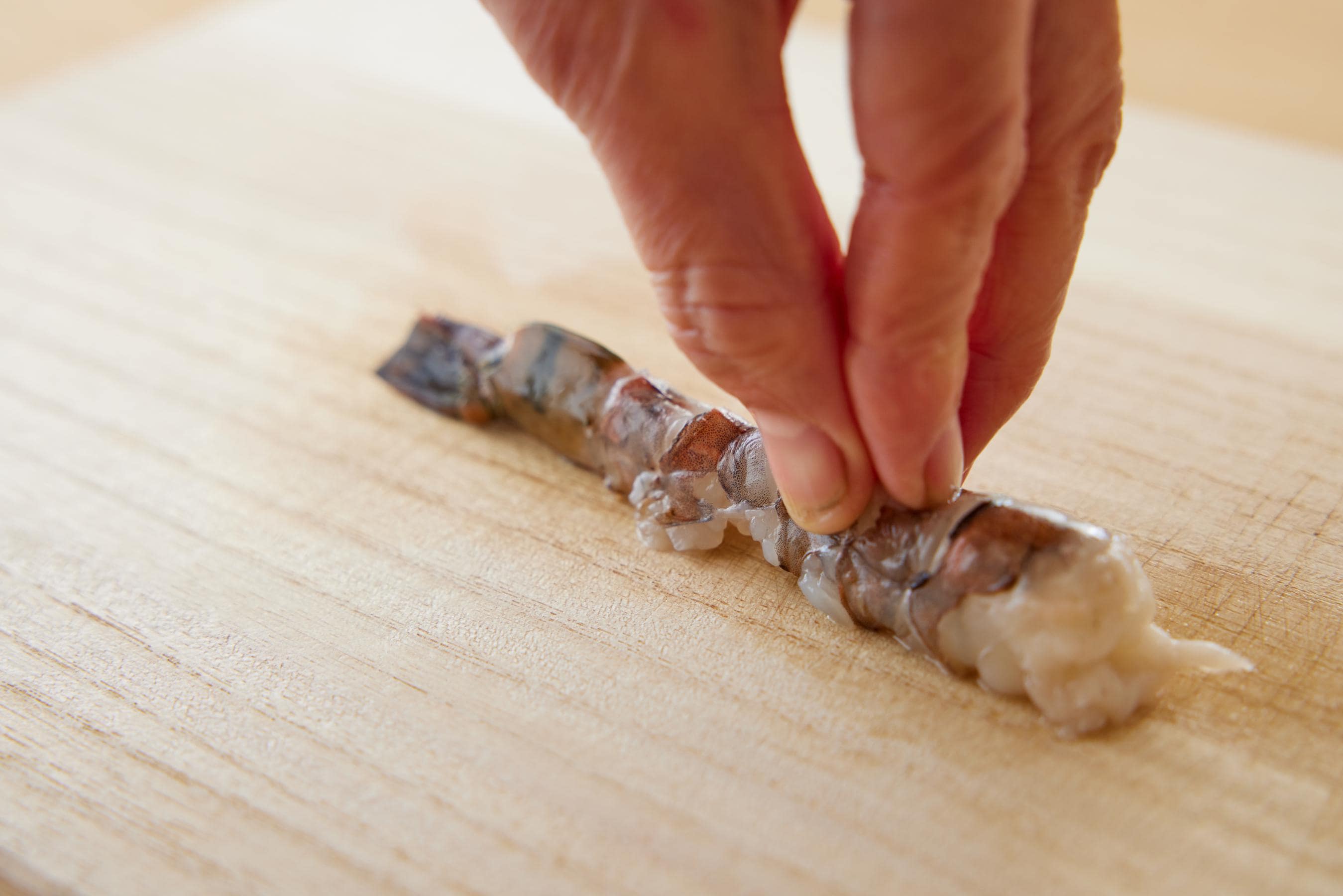
- 5With the belly side facing downward, lightly press down on the shrimp so that it is stretched out straight.
- TipsMaking incisions into the belly side cuts the ligaments. Applying light pressure to straighten out the shrimp will give it a more appealing shape once fried.
Watch video for preparing the ingredients
How to Prepare Garnish
After peeling its skin, grate the daikon radish, then lightly remove any excess moisture. Do the same for the ginger.
Watch video for preparing garnish
How to Make Tempura Dipping Sauce
Pour mirin into a microwave-safe bowl and heat uncovered in a microwave for 1 minute (600W). Heat dashi broth in a pot over medium heat, then add the mirin from the previous step and Kikkoman Soy Sauce, and bring to a boil.
Watch video for making Tempura Dipping Sauce
How to Make Tempura Batter
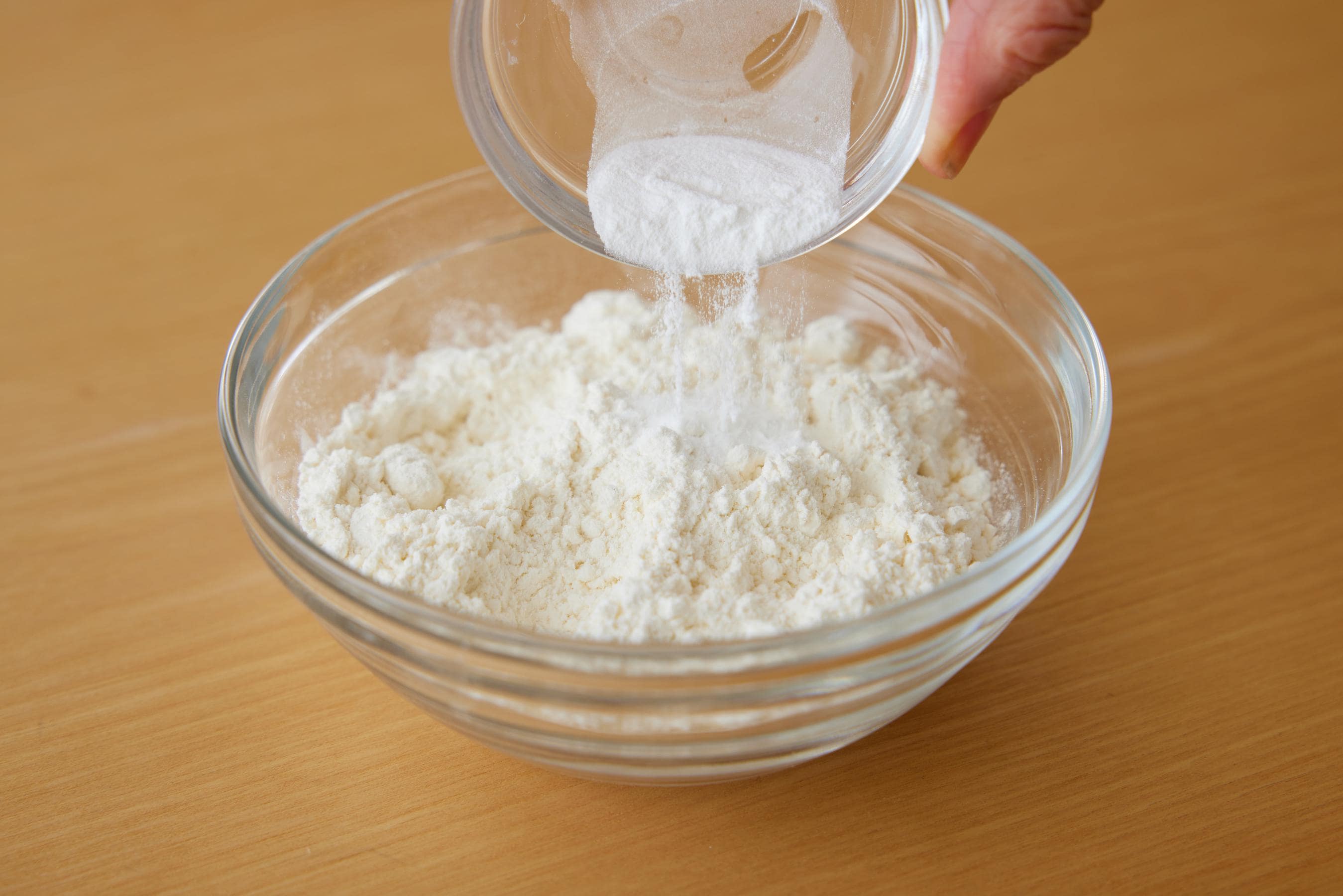
- 1Pour flour and baking powder into a bowl and mix them together with a fork.
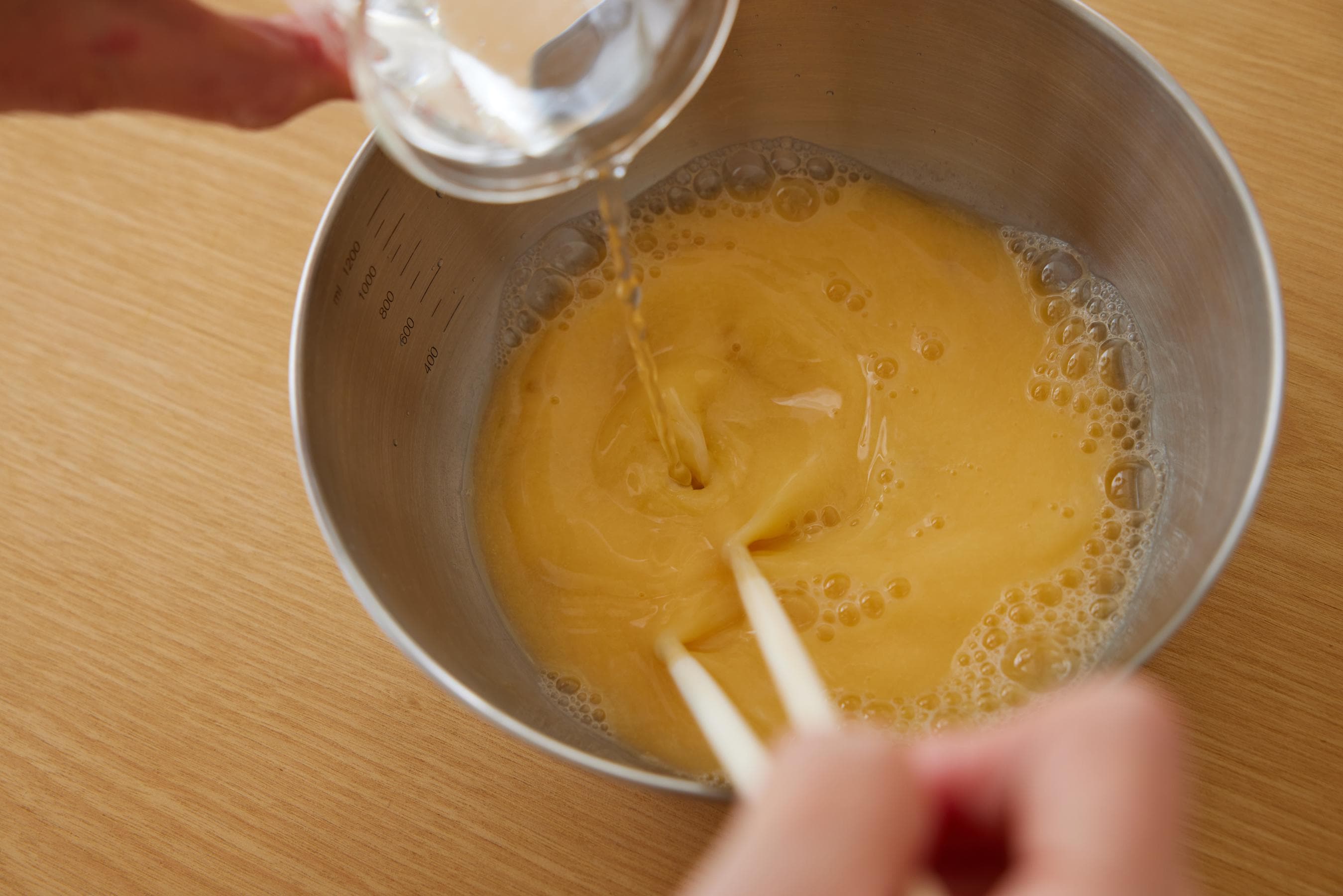
- 2Crack the egg into a separate bowl, beat, add cold water, and stir gently with chopsticks.

- 3Add in the flour & baking powder mix from the previous step and mix gently so that it does not become sticky.
- TipsIt’s best if the batter turns out as shown in the image. It’s OK if there is some flour left dry.
Watch video for making Tempura batter
How to Deep Fry the Tempura
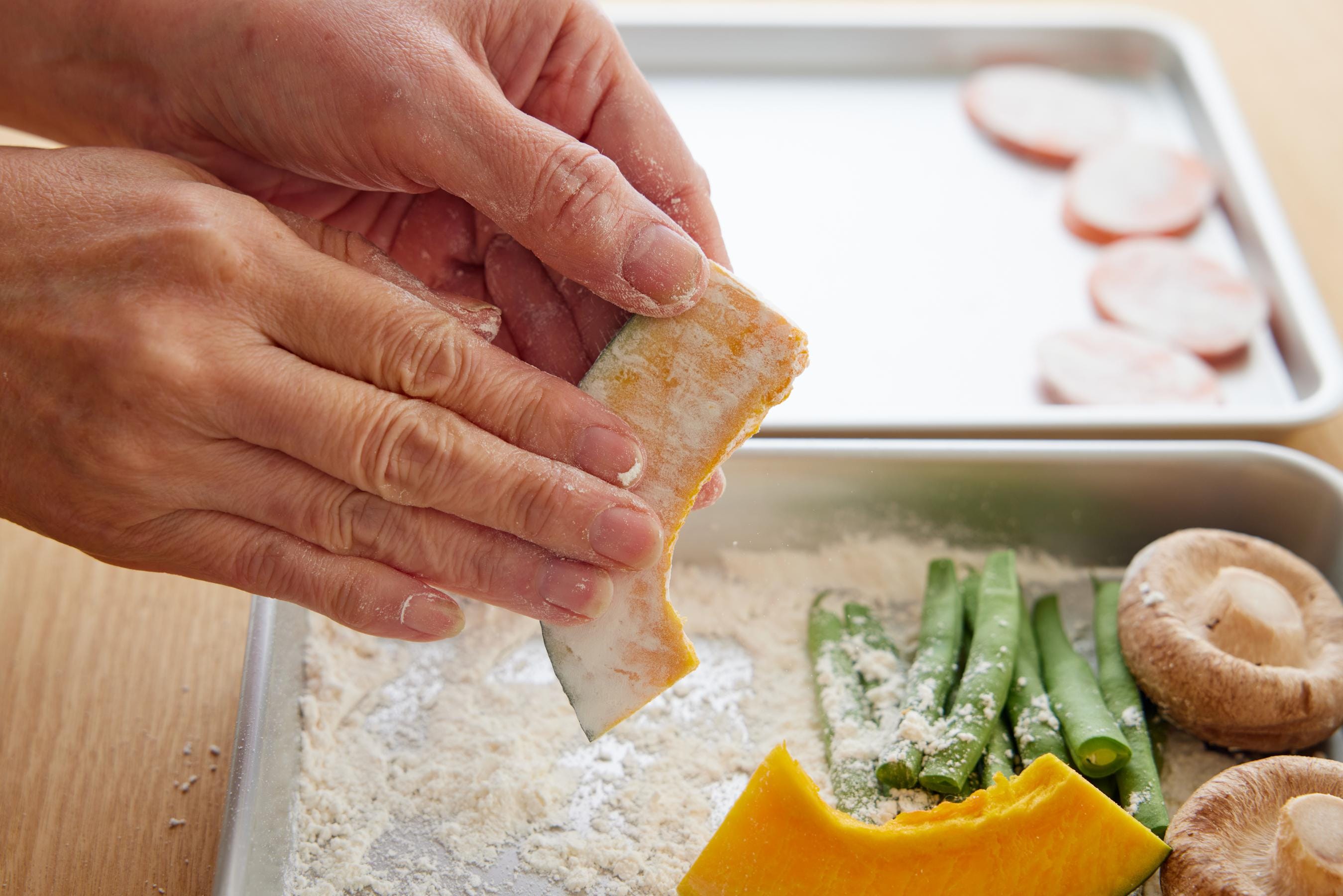
- 1Dust the vegetables with flour (separate from the ingredients listed), and lightly brush off any excess flour.
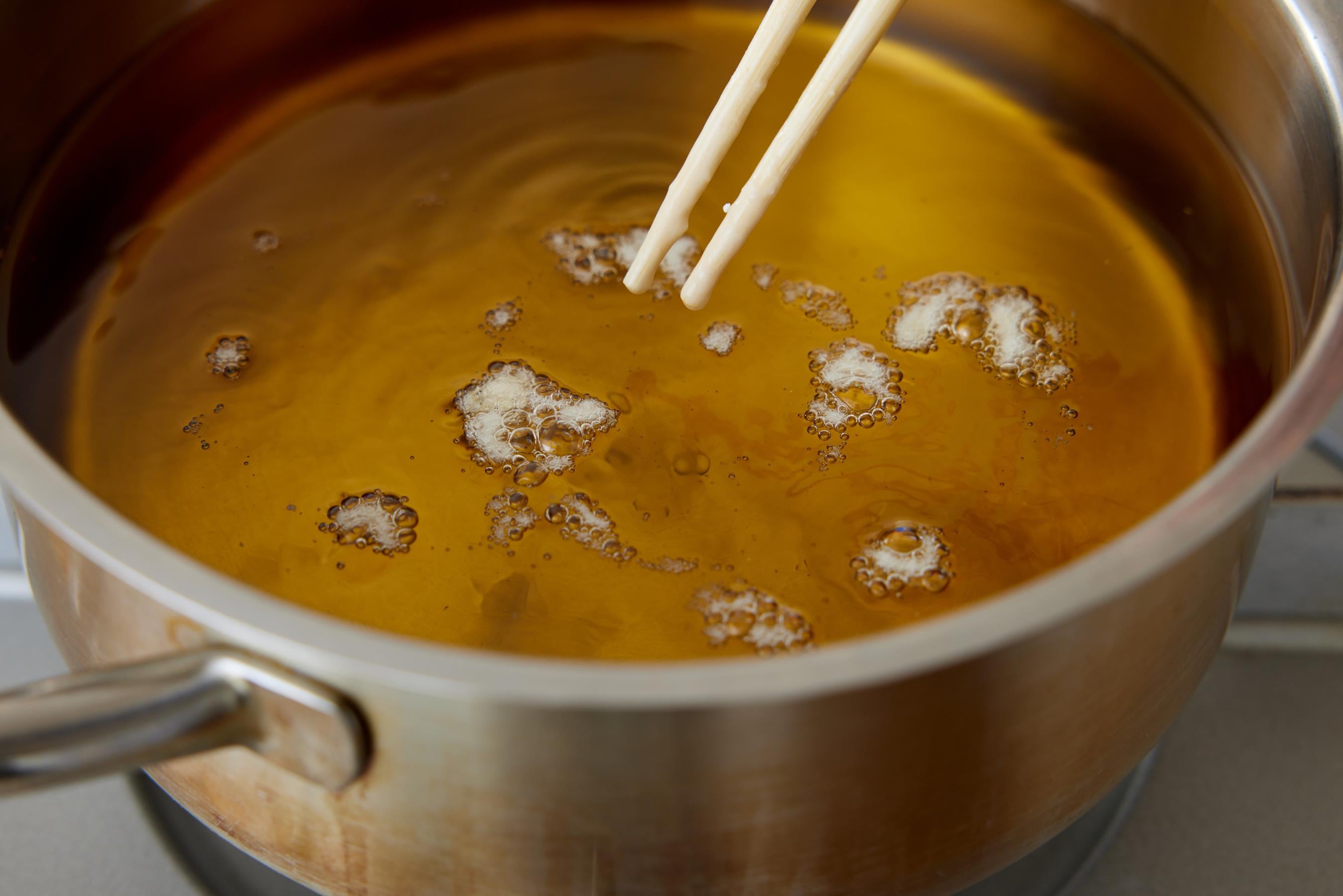
- 2Pour cooking oil into a pot and heat to 170℃. Drizzle a small amount of batter into the pot to test the oil’s temperature.
- Tips170℃ is the temperature at which the batter sinks to the bottom of the pot then floats right back up.
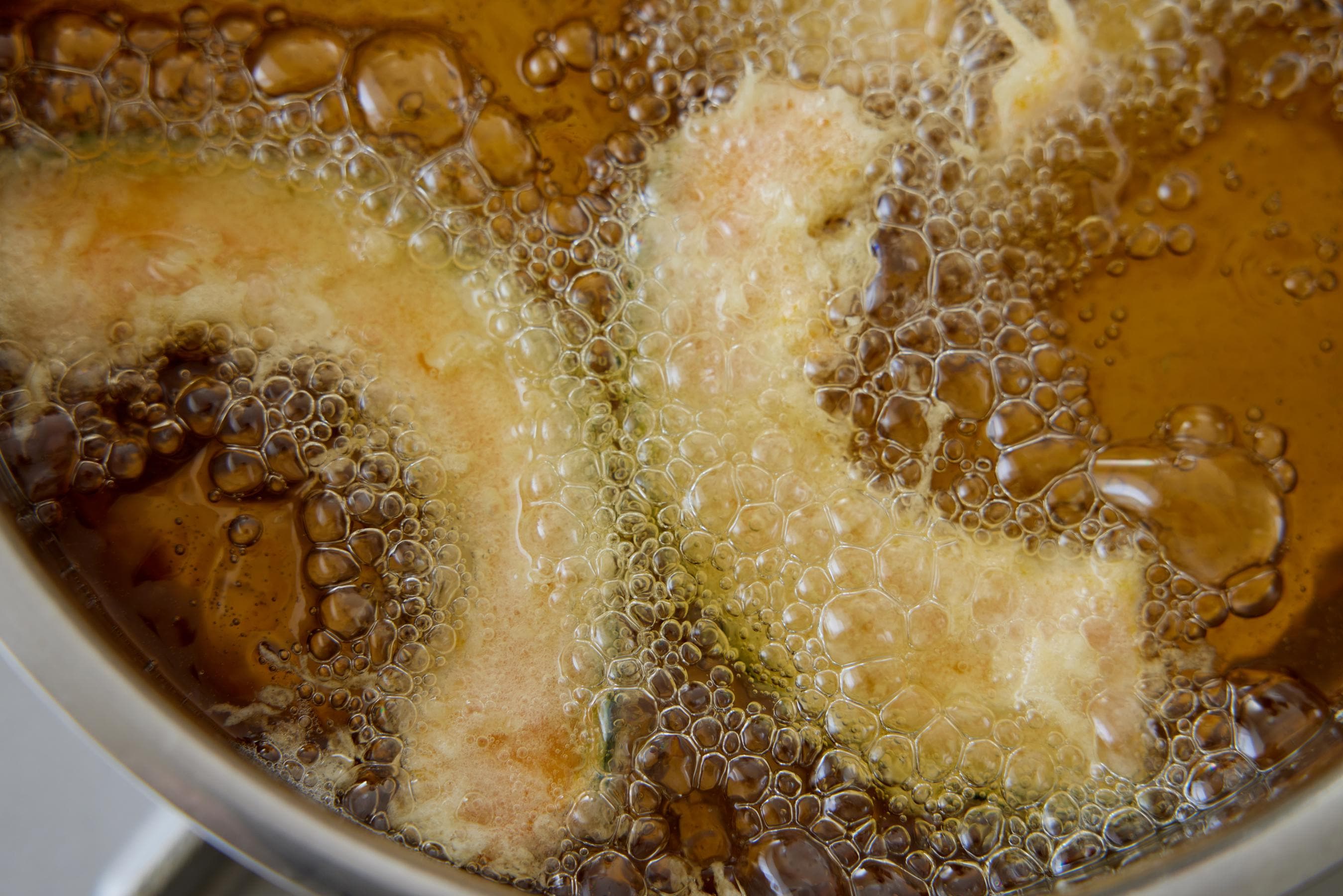
- 3Coat the flour-dusted vegetables in batter, then put a few pieces into the oil, allowing them to fry for 30 seconds. Then flip each one over in the pot.
- TipsIf you touch the ingredients immediately after placing them in the oil, the batter will fall off, so refrain from touching them till the surrounding batter has hardened.
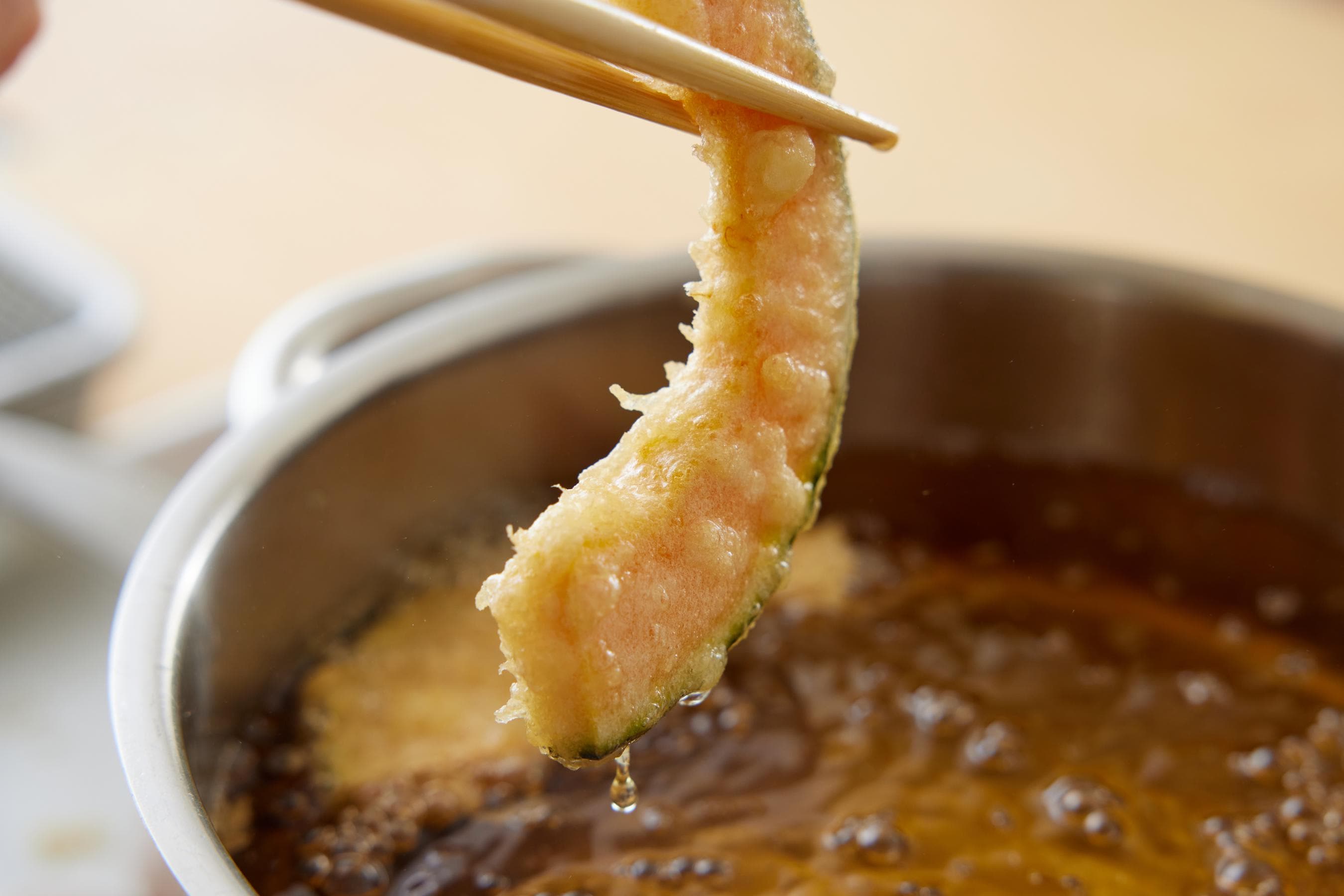
- 4After allowing the vegetables to fry for 1 to 2 minutes, set those Tempura onto a cooling rack to allow the excess oil to drip off.
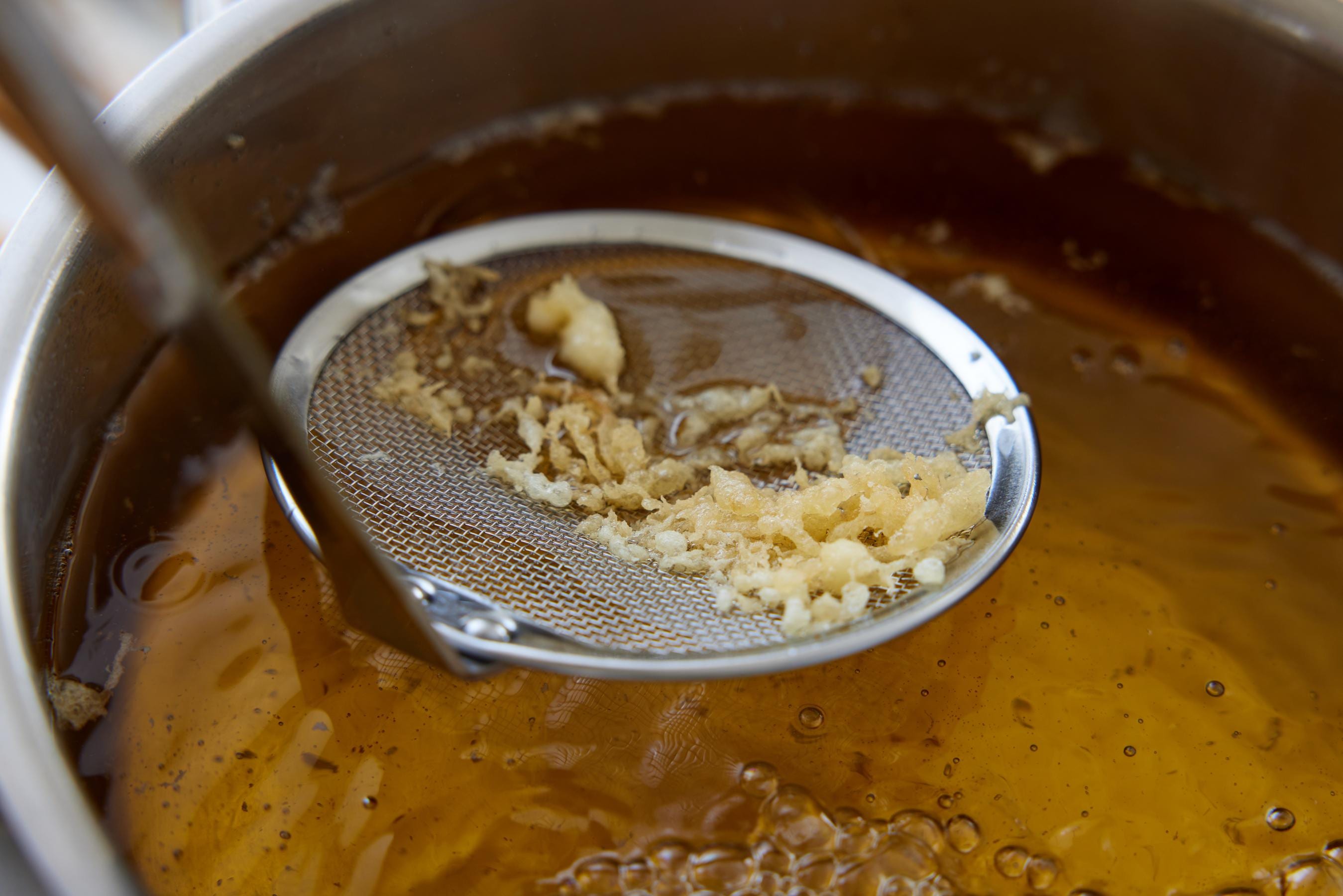
- 5Any crumbs of batter that fall off will float in the oil, so use a frying colander to remove them from time to time.
- TipsBy doing it, you can keep the oil cleaner which will keep your Tempura tasting great!
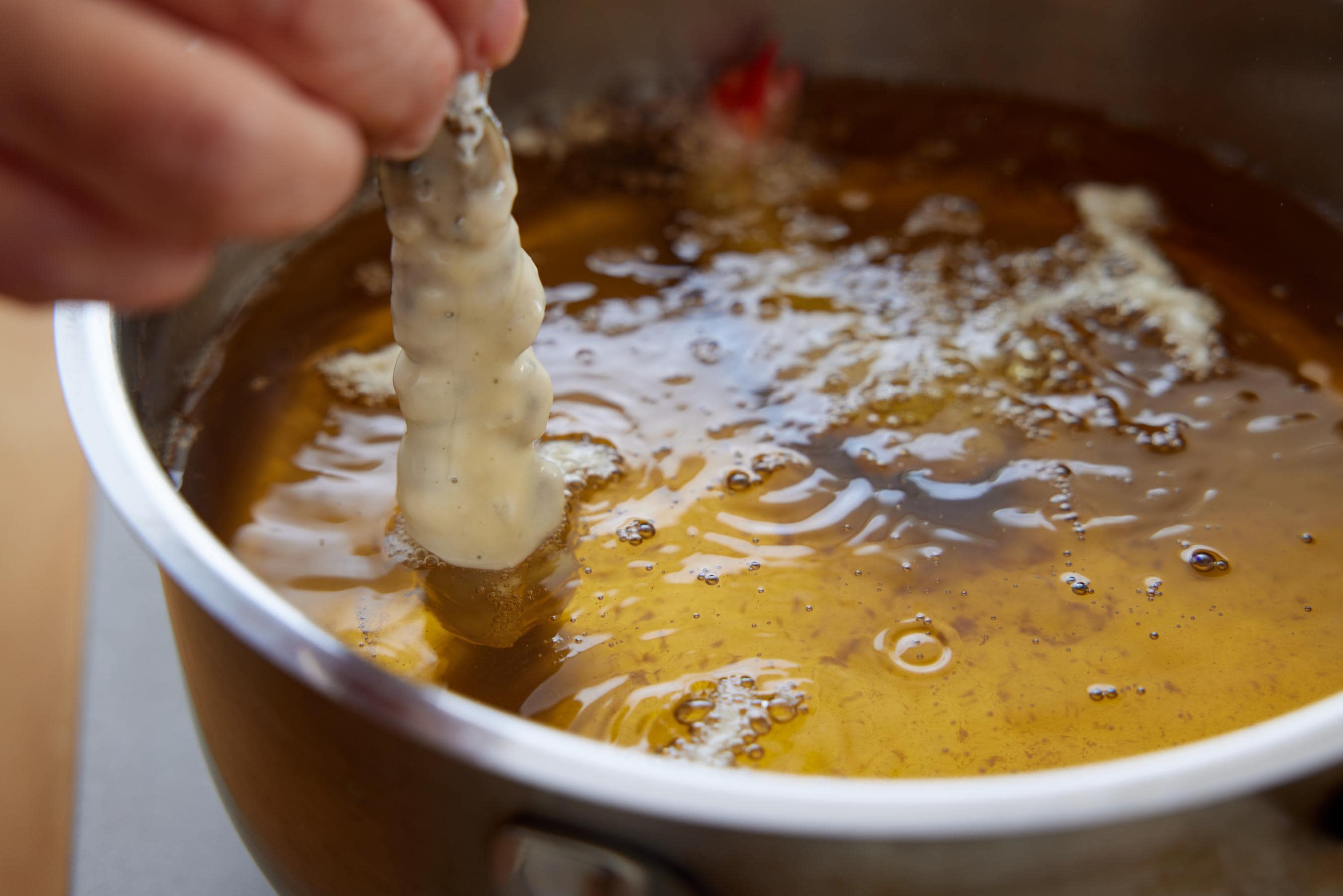
- 6Coat the flour-dusted shrimps in batter, then put a few pieces into the oil, allowing them to fry for 30 seconds. Then flip each one over in the pot.
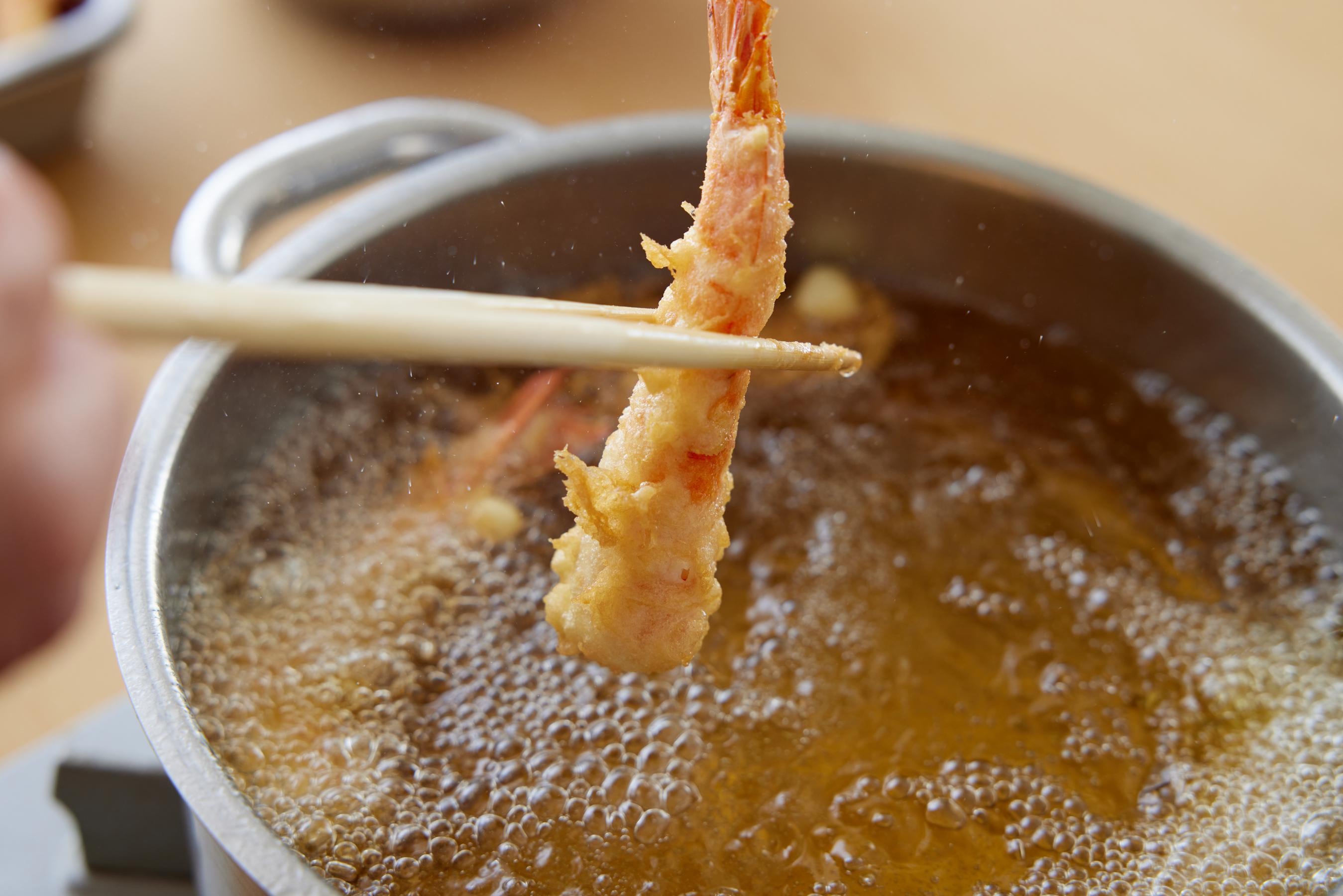
- 7After frying each shrimp for about 1 to 1.5 minutes, set those shrimp onto a cooling rack to allow the excess oil to drip off.
- TipsDraining the excess oil off will prevent the Tempura from turning sticky, and will give them a nice texture.
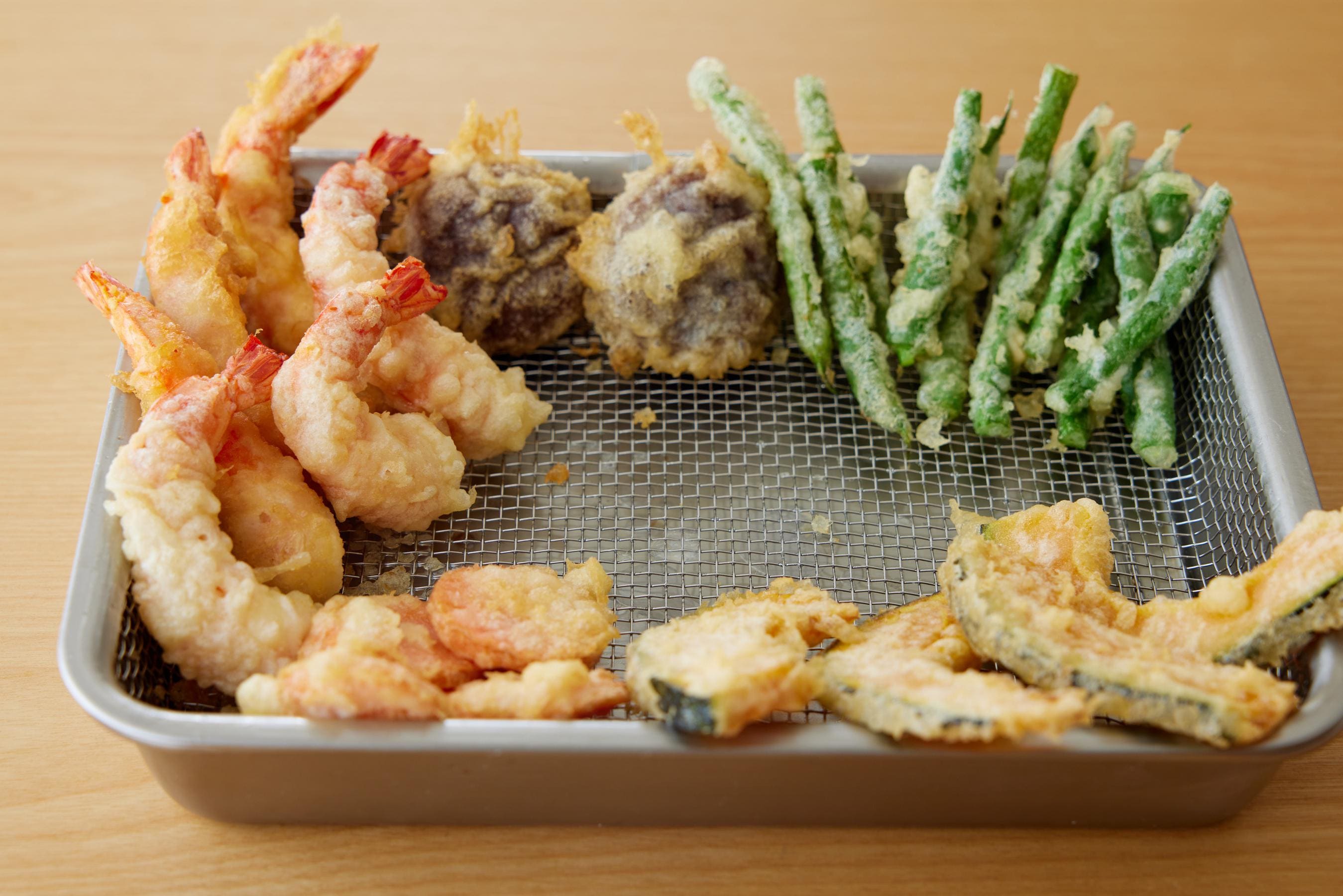
- 8As best as you can, arrange the fried vegetable and shrimp Tempura in a way that they stand against each other so that excess oil can drip off.
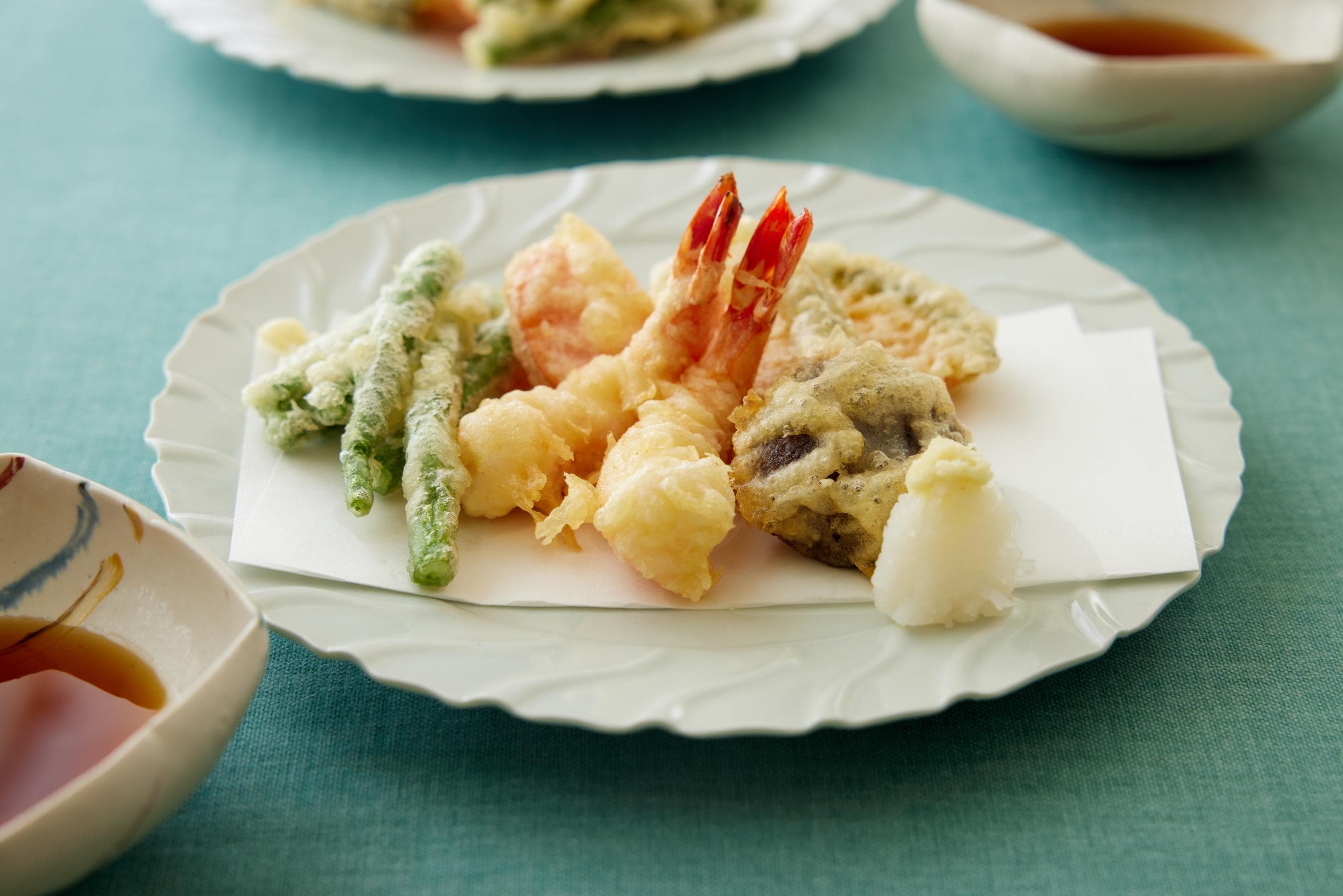
- 9Finally, arrange them on a plate garnished with grated daikon radish and ginger. Then dip in the Tempura dipping sauce and enjoy!
Watch video for deep frying the Tempura
More Ways to Enjoy Tempura
Try Out Variations Using Your Favorite Sauce
Tempura also goes great with seasonings like soy sauce and mayonnaise. You can even pile Tempura onto a large plate and serve it with several different sauces—great for serving at parties! Here, we’ve served Tempura alongside soy sauce, mustard, a mayo-chipotle-ketchup sauce, and salt.
Sprinkle Fry Batter Crumbs Onto Salad
The fry batter crumbs that fall off while frying Tempura are called “Tenkasu” in Japanese. Their crispy texture and oily richness are tasty, so in Japan, these crumbs are used to sprinkle on udon, on rice with a dash of soy sauce, or as a topping for other dishes. They go great with vegetables, so we also recommend them on salads!
Turns the Leftover Batter into Snack
If you have leftover batter, you can add flour and a little sugar, then mix it together and deep fry till you have plump pieces.
FAQ
What Vegetables are Best for Tempura?
Vegetables that don’t have much moisture can be used for deep frying. We recommend such vegetables as zucchini, eggplant, and green and red bell peppers. Okra and shishito peppers also work well. You can even try frying potatoes and sweet potatoes.
What Should I be Careful of When Prepping the Vegetables?
For vegetables such as Okra and shishito peppers that have air in them—if fried as is—the air inside will expand and explode when heated, causing oil to splatter. Be sure to cut a slit in such ingredients before frying. The same goes for bell peppers.
Kitchen Utensils Used in This Recipe
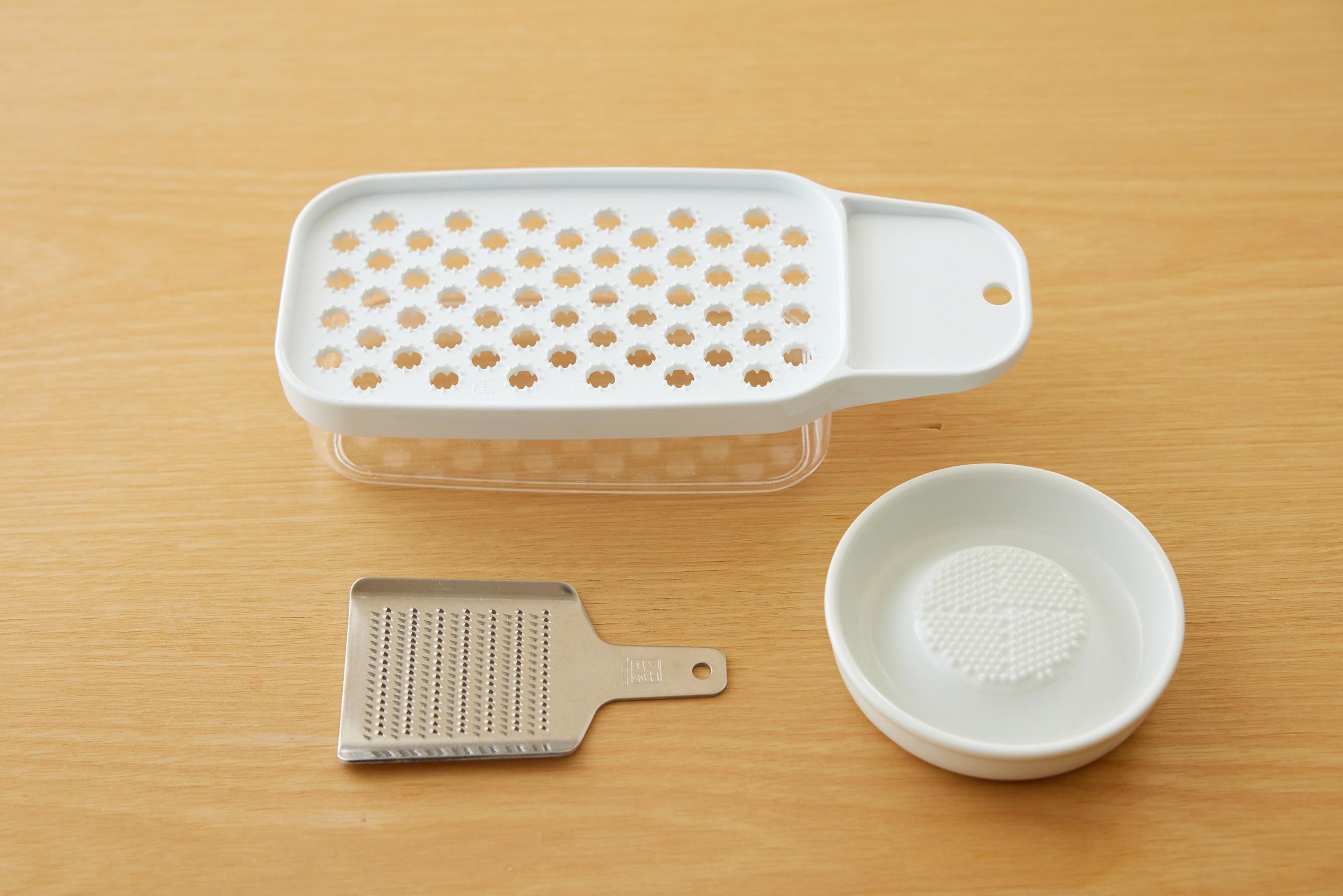
Grater
In Japanese cuisine, grated vegetables are often served alongside dishes as "yakumi" (garnishing condiments). This is to bring out the aroma and spiciness of the vegetables and accentuate the dish. A grater is used to grate vegetables. The surface of the grater has protrusions that grind vegetables into small pieces by rubbing them against the grater. Graters are made in a variety of materials such as plastic, metal, and ceramic. The texture of grated vegetables differs depending on the size and arrangement of the grating holes, and different types of graters are used for different dishes.
For more information about Grater, please see our Glossary page.
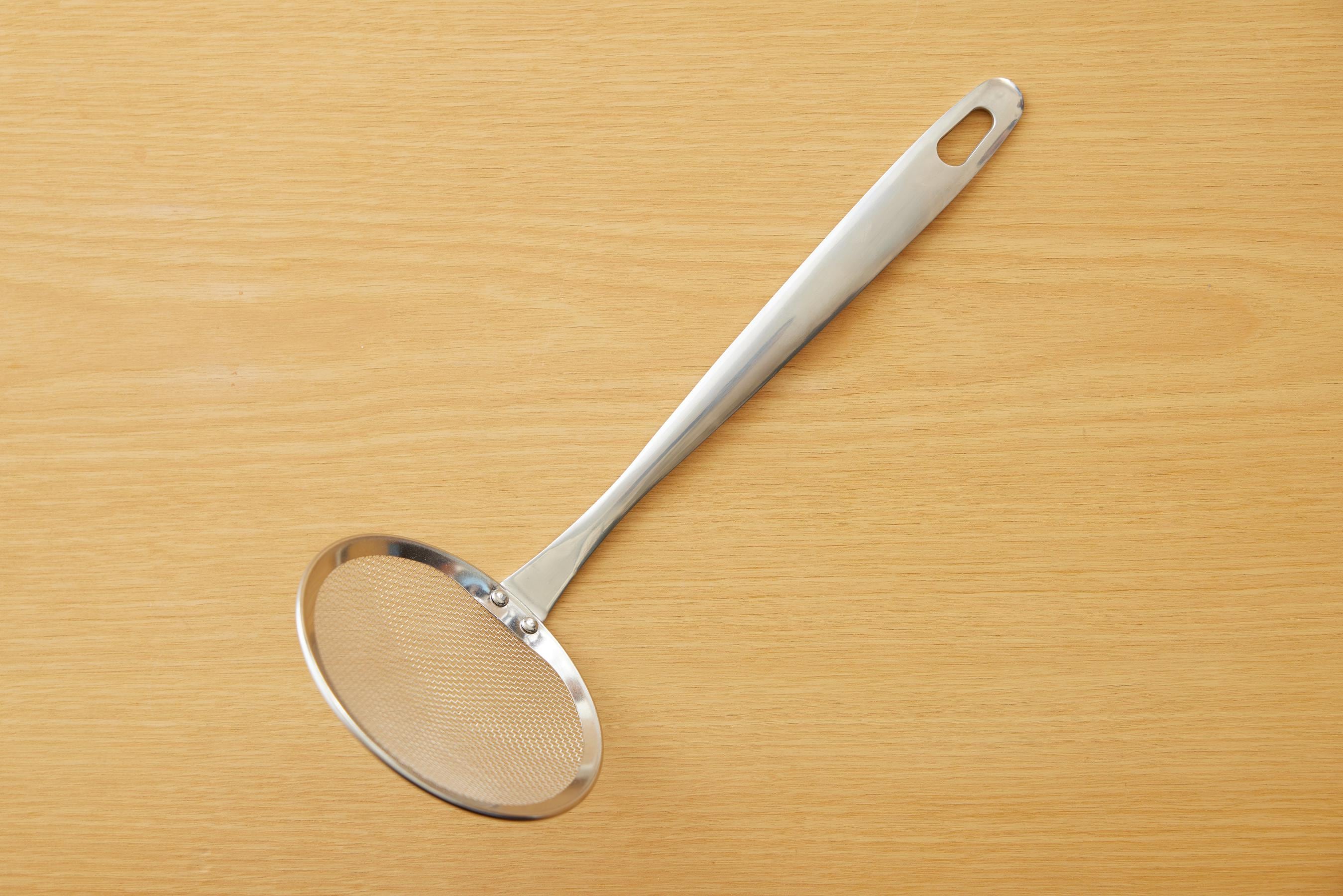
Frying Colander
On the end of this cooking utensil’s handle is a fine mesh. When frying, you can use a frying colander to remove the crumbs of batter (“Tenkasu”). The finer the colander’s mesh, the easier it will be to remove crumbs from the oil.
For more information about Frying Colander, please see our Glossary page.
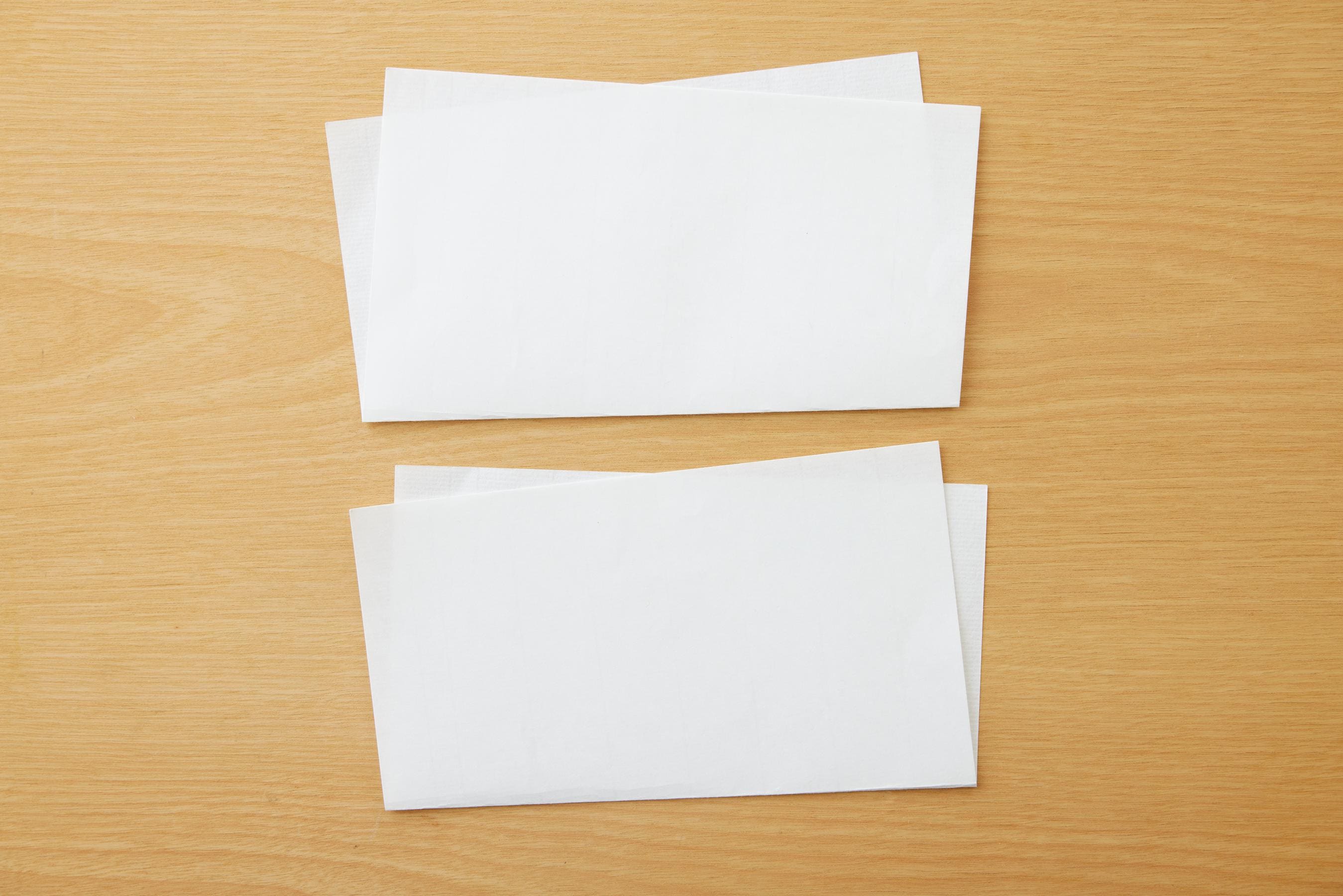
Tempura Paper
Sometimes paper is laid on top of a plate to serve Tempura. This Tempura paper is called “tenshi” or “Tempura-shi” in Japanese. Although not often used for home cooking, this Tempura paper is used at restaurants for more formal arrangements, or for celebratory (congratulatory) or eulogy (funeral or memorial service) meals. The upper photo shows the folding method used for celebratory occasions, and the lower photo shows the folding method used for occasions of mourning.
Kikkoman Products Used in This Recipe
About the Recipe Author
Yuko Ihara
Having lived in England and the U.S., Yuko Ihara is well-versed in a wide range of culinary genres. As a culinary researcher, she creates dishes for magazines and books, develops corporate menus, and also engages in product development and food consulting. She introduces easy-to-follow tips on how to make delicious food at home, emphasizing the importance of seasonality and healthful eating. When travelling, she loves to search for delicious vegetables and ingredients.
Instagram: @iharayukoo
About Washoku Lesson
Washoku Lesson is special content offering detailed and easy-to-understand explanations, including tips for making classic Japanese dishes as well as the many ways of enjoying these, and introductions to special Japanese cooking utensils and annual events.
Related Recipes
30min
483kcal
600mg
20min
321kcal
600mg
15min
218kcal
400mg
25min
499kcal
600mg


